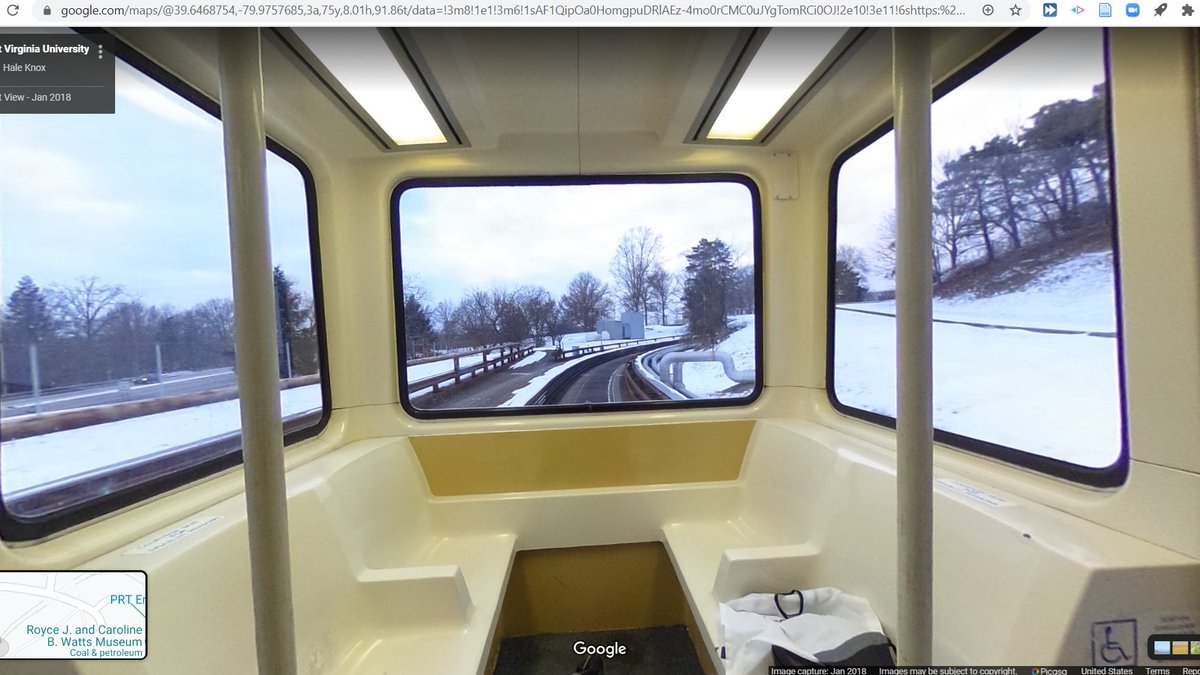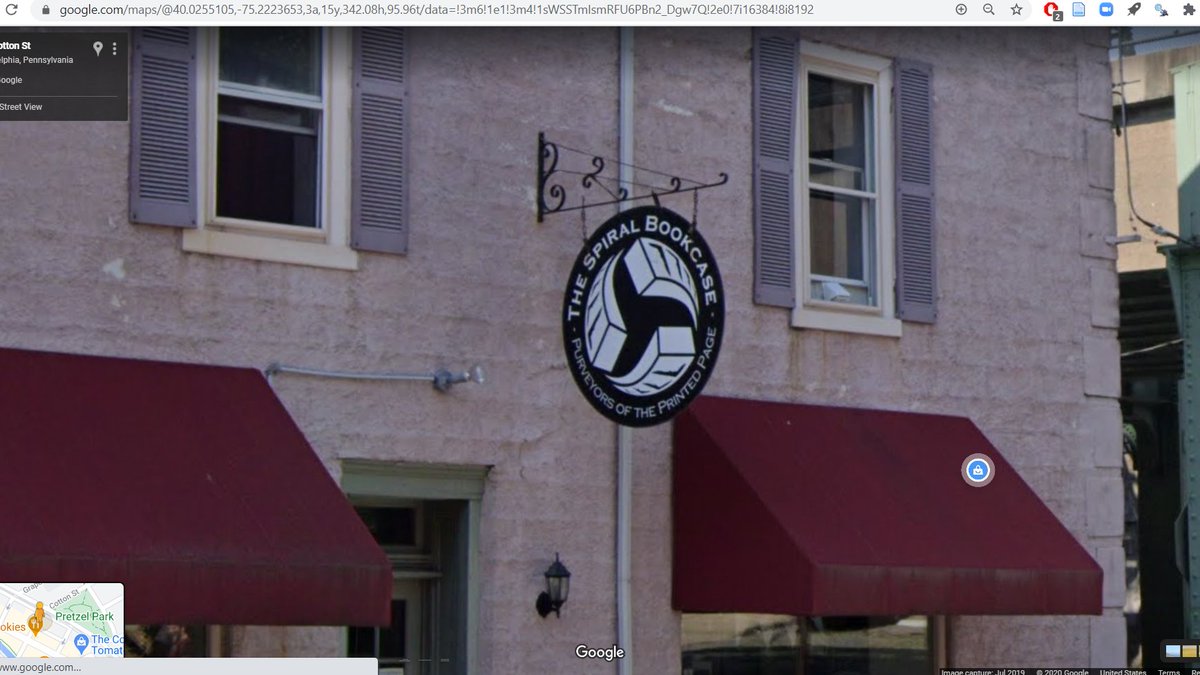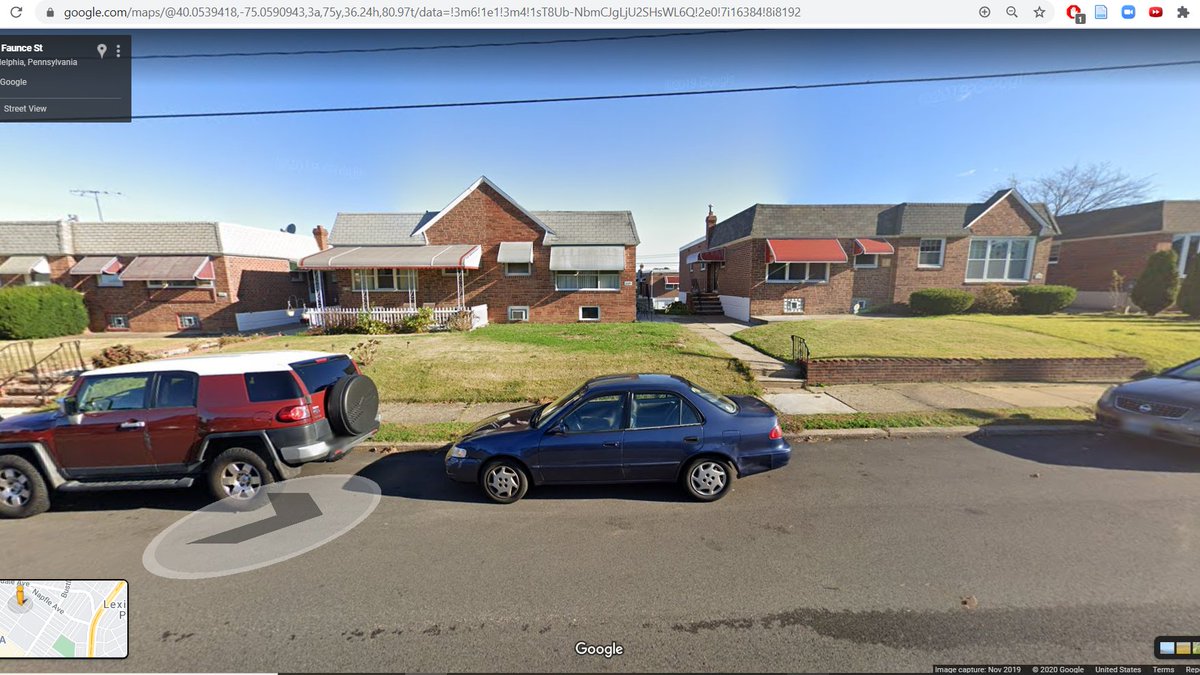Entering Milwaukee #SEANYC 

This sad looking bit of track may not look like much, but is in fact the last remnant of Milwaukee's storied Beer Line, a once-bustling industrial route through the city owned by the Milwaukee RR. We'll be loosely tracking this ROW. #SEANYC 

Thanks to racist land use/transportation/governmental geography policies, Milwaukee is one of the most segregated cities in America. I'm near the intersection of Locust and Humboldt on the map attached. #SEANYC 



Worth noting that, among myriad other issues, Milwaukee's extreme urban-suburban divide is now exploited heavily by the state GOP in order to reduce the political power of Democrats in state government. See:
urbanmilwaukee.com/2018/06/09/the…
brennancenter.org/our-work/court…
urbanmilwaukee.com/2018/06/09/the…
brennancenter.org/our-work/court…
The Beer Line in Milwaukee got its name from the breweries it once served. Among others, Schlitz and Pabst once had large facilities just north of downtown MKE, which, with volumes of inbound grain and outbound beverages, functioned as anchor customers for the line. #SEANYC
Relatively little is left of this landscape. We're looking at the middle of the older image, next to the tracks leading off to the right #SEANYC
pinterest.com/pin/4604227618…

pinterest.com/pin/4604227618…


There certainly remains some brewing in Milwaukee, but most of the industrial-scale stuff seems to have moved away -- with the exception of Miller in the aptly named Miller Valley. For its part, the Beer Line was abandoned in 2007, after its last major customer closed. #SEANYC 

Apologies to my longtime followers, but I want to belabor the importance of industrial sprawl to urban poverty. The (subsidized) suburbanization of well paying low/med skill jobs is inextricable urban economic hardships. This isn't just a story of buildings/railroads/etc. #SEANYC
scenes from downtown, feat. mixed traffic streetcar by the Amtrak station #SEANYC 





I-94. West of here, WIDOT wants to spend 1 billion to widen the road, a project championed by both Scott Walker and Tony Evers--despite a lawsuit led by the NAACP, Sierra Club, local Milwaukee advocates and the ACLU to block it.
wpr.org/naacp-official…
jsonline.com/story/news/pol…
wpr.org/naacp-official…
jsonline.com/story/news/pol…

(and see usa.streetsblog.org/2015/03/24/how… for info on how they deemed the stretch unsafe)
MCTS's Purple Line, one of their high-frequency limited stop BRT-lite services. There is a Blue, Purple, Green, Gold and Red line. 

Progress has been a bit slow the past few days, but that's to be expected now that we're in larger cities. #SEANYC 

Former Chrysler/American Motors engine plant in Kenosha, WI. A former part of a dispersed auto parts manufacturing geography that's rapidly becoming obsolete as just-in-time manufacturing favors colocation of parts and assembly plants. #SEANYC 

For those not acquainted with it, the North Shore Line (CNS&M) was an interurban railroad that ran from Chicago to Milwaukee. It was one of the longer lasted interurban operations, closing only in 1963. For more, see: american-rails.com/cnsm.html
#SEANYC
#SEANYC
Kenosha still gets rail service via Metra's UP-North line, which stops here along an ex-Chicago and Northwestern route. #SEANYC 

And now, the reason I'm visiting Kenosha: its PCC trolleys. Since 1998, Kenosha has operated a loop trolley connecting the Metra station with a lakefront development. It runs a number of (mostly) ex-Toronto PCC cars. #SEANYC 

This loop is (arguably) one of the first examples of modern streetcars as development-oriented transit; the genesis of this loop was the redevelopment of the town's industrial waterfront. #SEANYC
This road *is* the WI/IL border #SEANYC 

An elderly coal fired power plant along the lake in Waukegan: #SEANYC 

EJ&E over the ex-C&NW in North Chicago. This is the far northern end of the EJ&E, a belt railroad that circled Chicago and is now (regrettably -- could have been immensely useful as a public asset) part of CN
industrialscenery.blogspot.com/2019/01/ej-elg…

industrialscenery.blogspot.com/2019/01/ej-elg…


Glencoe, IL: one of the first towns to ever adopt a zoning ordinance (1921). Surprise surprise, it restricted development to single fam homes outside of its little downtown, and banned industrial uses.
lib.niu.edu/1987/im871205.…
#SEANYC
lib.niu.edu/1987/im871205.…
#SEANYC

The CTA is somewhat unique among rapid transit systems in that its routes still have grade crossings! Here's the far northern end of the Purple Line in Evanston. This particular portion of the CTA system was used by North Shore Line trains following their easterly route. 

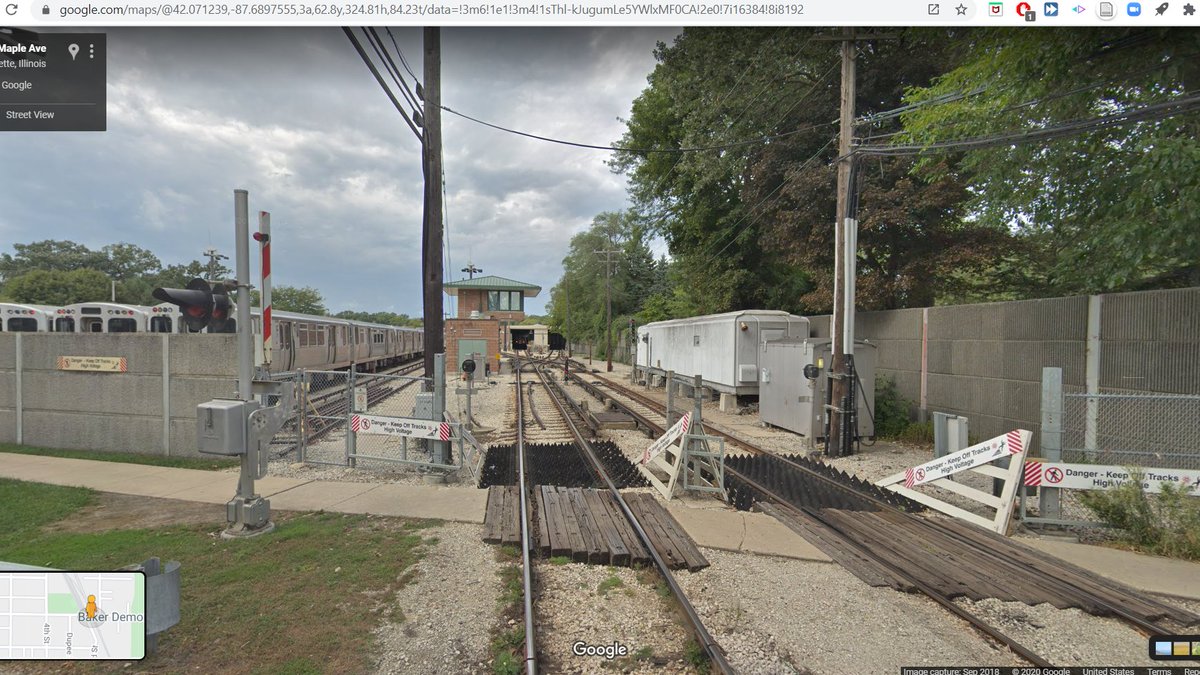

(image from american-rails.com/cnsm.html#gall…)
Take 2 of the images in tweet before last

https://twitter.com/jeremyzorek/status/1286137094960828418?s=20

'Downtown' Evanston #SEANYC 

I love that street view has alleys like this. Currently crammed btwn the Metra UP-North line (ex-CNW) and some houses. #SEANYC 

Howard! This station is the:
- North end of the Red Line
- South end of the Yellow Line
- South end of the Purple Line during off peak hours; a through stop during peak
- The location of a major yard
...or the Chicago equivalent of the E 180 area in NYC. A v complex operation.
- North end of the Red Line
- South end of the Yellow Line
- South end of the Purple Line during off peak hours; a through stop during peak
- The location of a major yard
...or the Chicago equivalent of the E 180 area in NYC. A v complex operation.

The saving grace for the area is the fact that Chicago (brilliantly IMO) makes the middle pair of tracks local and the outer pair express on their 4 track lines. 

During the rush, Red line trains, (local south of Howard) can pull in on the middle tracks and loop around. Purple line trains (which run express south of Howard and go north on the tracks running along the sides of the loop) just stick to to the outside.
Yellows (coming from the tracks that pop up btwn the loop's sides) weave their way through; I've read they either turn on the outside tracks or use that little spur at right.
And, to top it all off, you have plenty of movements to/from the yard during rush hours. Those moves, sadly, are not grade separated, which I'm sure makes for some ~fun~ junction operation (esp given the complicated, tight and therefore somewhat slow switchwork) #SEANYC
Lots of these apartment buildings w/ mid-block service alleys here along Clark St. Would love to know the history of the design, if anyone here does. #SEANYC 

Clark Junction, where CTA's Brown (right) and Red/Purple (left) lines converge at a flat interlocking. CTA is currently in the process of grade-separating the area to eliminate the conflicts caused by Brown Line trains crossing over 3 tracks to escape to Ravenswood. #SEANYC 

Project details can be found here: transitchicago.com/rpm/rpb/#:~:te…. As I've discussed in the past, this project is an epitomizes the 'weakest link' investments that should be more the norm for US transit agencies; they're not as fun as a new line, but they're the highest value/dollar.
Taking a quick dip on my way to Goose Island. I really hope that streetview expands its river coverage; it's great stuff. #SEANYC 

Goose Island--which once was really just a gigantic train yard--has a fun shared rail + pedestrian bridge at its north end. The rail half of its use has been out of service since 2015, sadly, and is now undergoing trail conversion.
industrialscenery.blogspot.com/2017/05/railro…
clearinghouse.isgs.illinois.edu/webdocs/ilhap/…

industrialscenery.blogspot.com/2017/05/railro…
clearinghouse.isgs.illinois.edu/webdocs/ilhap/…


The one-time site of the Cabrini-Green homes, one of the more infamous public housing projects in the US. Explaining what caused decline at the project is a subject that can (and has) filled many books, but I want to touch on a few here #SEANYC 

It's first worth noting that the project's eventual function as a segregated, disinvested and socially isolated space was not by design; the original public housing plans for Chicago contained both slum replacement housing, and housing in suburbs.
The two were to work in concert, city-edge housing providing capacity to allow wholesale replacement of slum districts, in what was seen then as a progressive vision for housing. The merits of this approach can and should be debated...
...but I think it's key here to recognize the wholesale rejection of city-edge housing projects by white councilmembers using local control veto points as a critical turning point in the fate of the CHA writ large.
Ofc, location isn't everything: later events, whether that be the laser focus on unit construction costs (which led to tall bldgs w few elevators), blatant racism in tenant selection and agency budgeting, the disappearance of federal support in the 1980s, or managerial mistakes..
...on the part of agency staff and pols, were disastrous for the CHA. When combined with the generally anti-poor governmental environment of the post-Great Society era in the US they affected decline, and should be recognized for such alongside segregationary planning.
As for what has happened to Cabrini: after the Gautreaux ruling found the CHA to be intentionally segregating Black people and given the agency's chronic issues, the 90s and 00s saw a movement towards scatter-site public units and the demolition of legacy projects.
As such, Cabrini is currently being redeveloped (not without controversy about equity and inclusion in the new master plan) into a mixed income neighborhood.
A remnant of N Ogden Avenue, a diagonal Chicago street that has disappeared
forgottenchicago.com/features/the-e…
forgottenchicago.com/features/the-e…

(re: chicago public housing, I'd strongly recommend Hirsch's Making the Second Ghetto and Hunt's Blueprint for Disaster)
Last remnant of the Chicago NorthWestern/UP Navy Pier Spur, which once ran below Merchandise Mart to reach the lakefront at the Navy Pier. This was active delivering newsprint to the Sun-Times until about 2000. See: web.archive.org/web/2011072213… #SEANYC 

Under: Chicago Union Station north leads, used by Milwaukee North, Milwaukee West and North Central trains.
Over: Ogilvie leads, used by Union Pacific N/NW/W. #SEANYC
Over: Ogilvie leads, used by Union Pacific N/NW/W. #SEANYC

Union Pacific-West and the Union Sta. routes cross again a bit further west at this railway operations nightmare called tower A-2 #SEANYC 

Tower 18, the northwest corner of the Chicago Loop. This is among the busiest flat (ie no flyovers) interlockings anywhere. #SEANYC 
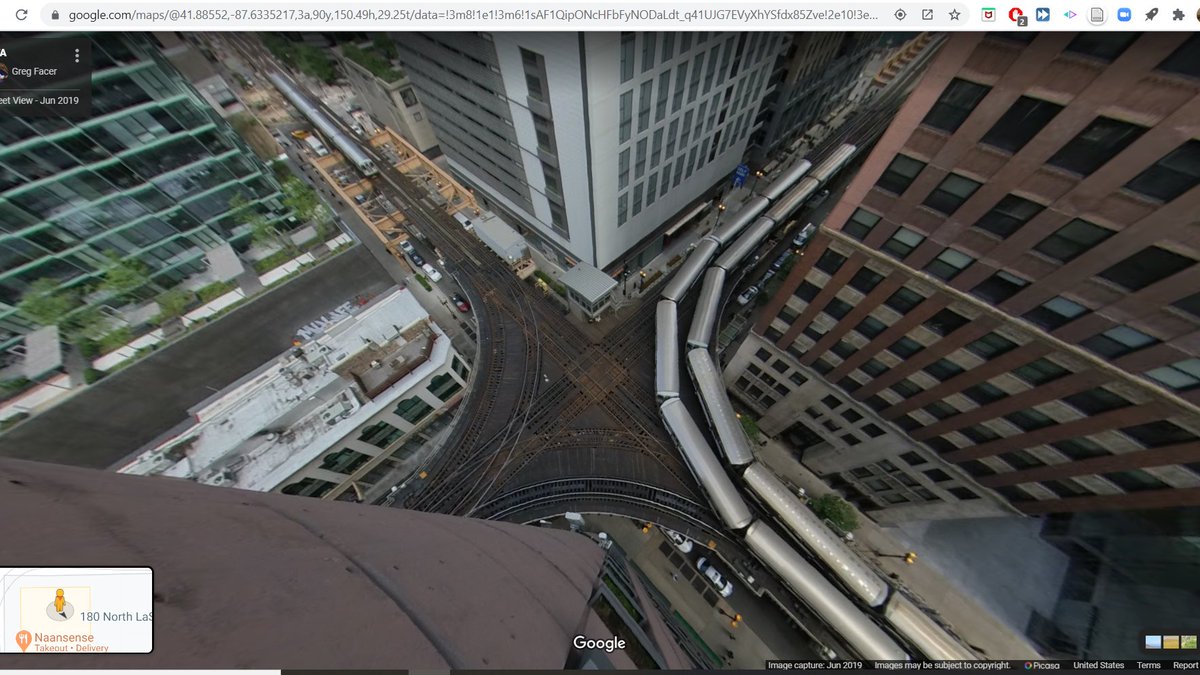
In the past (before the loop had signals), the loop handled as many as 85 (!!!!) trains per hour on one of its tracks. I'm astonished that could be made to work. 

While the loop has signals today, some aspects of the operation are suitably old fashioned. Thanks to the intensity of service at tower 18 during rush hours (trains passing <<<every 60 seconds), it's deemed prudent to have an operator on site to manage things.
So, despite the industrywide trend towards centralization, this junction still has a local tower operator who, IINM, dispatches trains on sight by looking at their marker lights (colored light pairs unique to each route). Truly a blast from the past! #SEANYC
UIC-Halsted on the Blue Line. This is an important short turn point for trains coming from the busy O'Hare branch of the Blue to the relatively less busy Forest Park branch.
drive.google.com/file/d/176eBdd…
drive.google.com/file/d/176eBdd…

This stretch of track along the Eisenhower expy is also among the earliest examples of freeway median transit in the US, a typology which the CTA embraced in the 50s and 60s with lines along the Eisenhower, Dan Ryan and Kennedy expressways
chicago-l.org/operations/lin…
chicago-l.org/operations/lin…
Passing under NS's 40 St Industrial Track. This route is ex-Rock Island; I believe it made its way to Conrail (and then to NS) when the former railroad was liquidated, and now serves as a key interchange gateway between NS and BNSF/UP. #SEANYC 

This area, much like the rest of Chicago, is extremely prone to congestion. The handoff process between railroads is a coordination problem that frequently goes unsolved, and things seem to get exponentially worse each time railroad traffic grows suddenly. #SEANYC
Some of that is infrastructure (LOTS of at-grade junctions), some of it is operations (coordination/crewing/handoff location issues), but either way if you're looking for the 80/20 in US transportation systems, fixing Chicago's rail network is probably it. #SEANYC
Former site of CHA's Robert Taylor Homes, part of the infamous State Street Corridor of housing projects next to the Dan Ryan on the south side. This was one of the sites chosen for PH after the rejection of suburban projects, and was only built in the early 60s. #SEANYC 

Chicago's growth patterns are worth a note here. While the city's population is stagnant (and is about 25% less than its peak), the region at large still nets small population increases. 


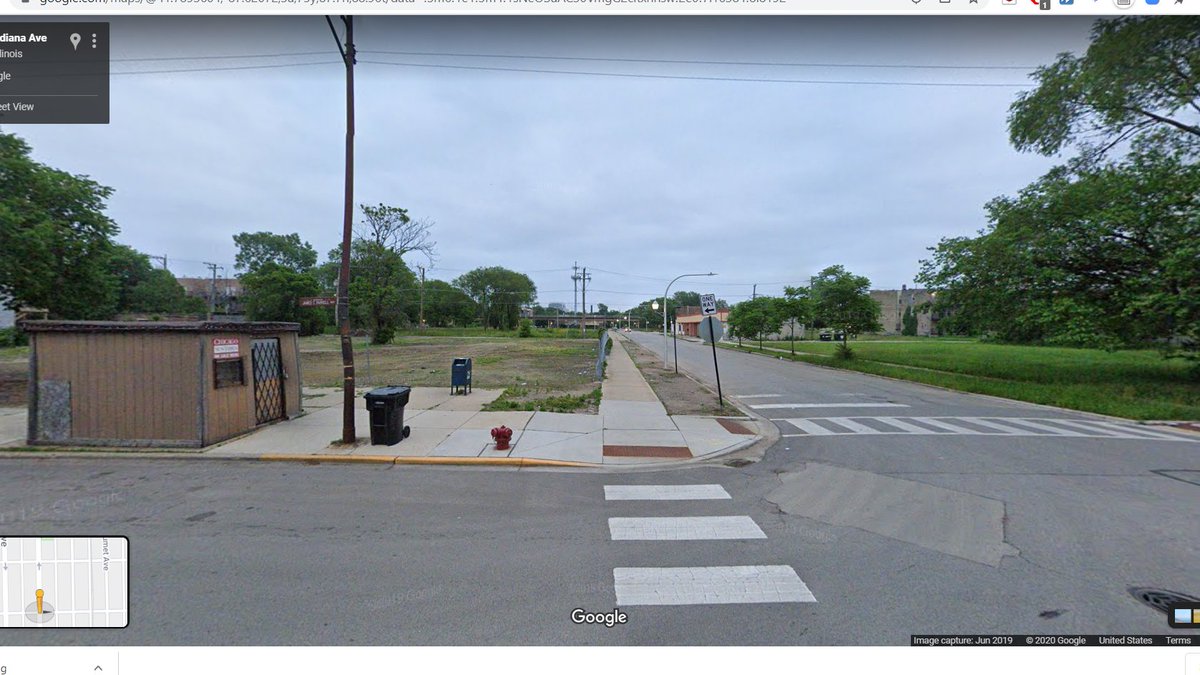
This slow growth region with no/negative growth central city pathology is common among post-industrial cities in the US, and is quite the testament to just *how* broken our incentive structures are around land use and sprawl.
Needless to say, this persistent disinvestment in central cities has really nasty side effects for regional politics, racial wealth gaps, employment opportunities and the like. #SEANYC
This is also a story of industrial sprawl, I should note. Many POC in Chicago were employed in industry, and that industry overwhelmingly decamped for the suburbs during the second half of the 20th century. #SEANYC 


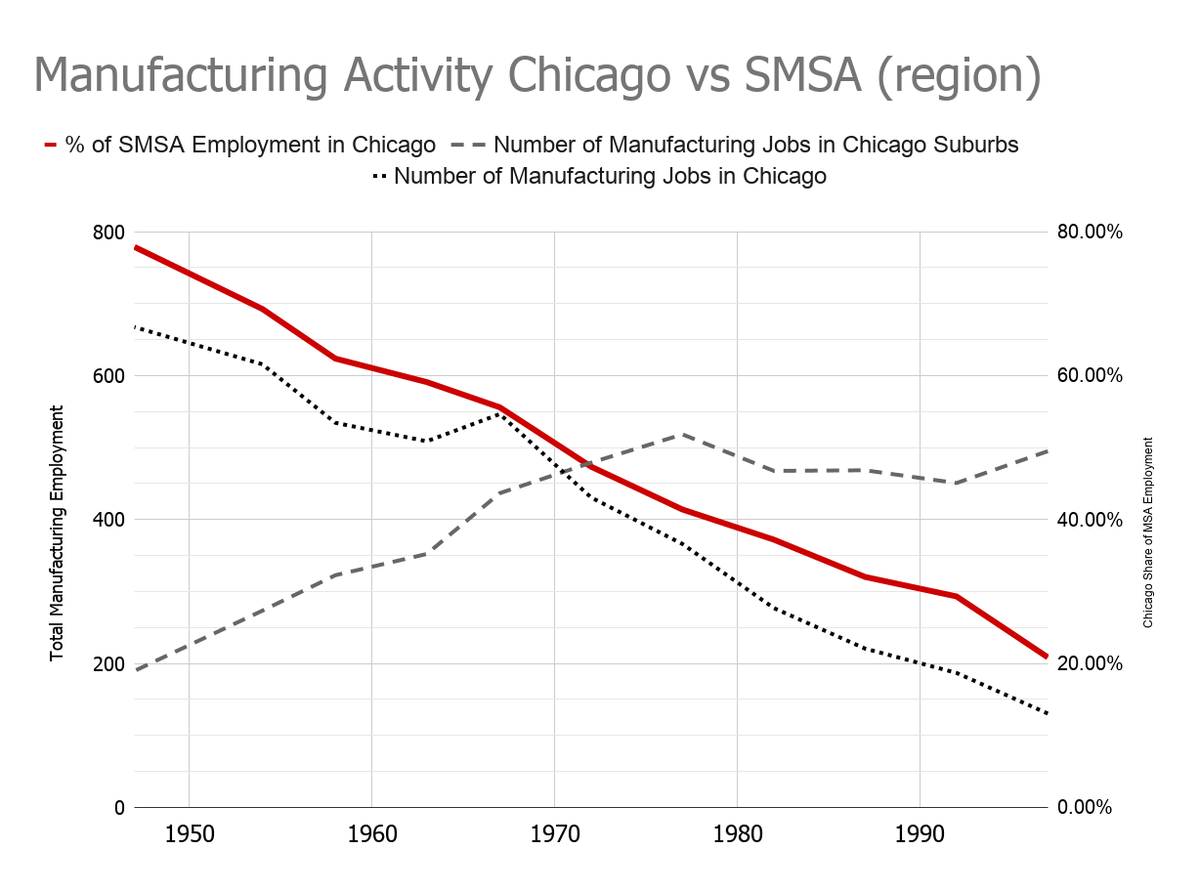
75 St: the worst of the worst when it comes to Chicago freight rail congestion. #SEANYC
cmap.illinois.gov/documents/1018…

cmap.illinois.gov/documents/1018…


Metra's South Chicago Branch. It once had 20 min base headways, it now runs hourly off peak. If you haven't read @sandypsj's thesis, which discusses the decline of this line in detail, you should:
itineranturbanist.files.wordpress.com/2016/05/final-…
timetable from: chicagorailfan.com/schedule.html
itineranturbanist.files.wordpress.com/2016/05/final-…
timetable from: chicagorailfan.com/schedule.html

The former site of US Steel's South Works, the westernmost major mill of the 'steel necklace' along Lake Michigan's South Shore. We're looking at the bin walls that once held inbound ore and coal for the furnaces. #SEANYC 

The decline of the US steel industry is a fascinating subject; as I've previously recommended in this thread, And the Wolf Finally Came is a good read on the subject. If you want a ridiculously short version, see here:
https://twitter.com/A320Lga/status/1250180599400316933?s=20
Worth keeping in mind that if all of these mills still existed, they'd still have shed massive amounts of employment since their peaks. You simply don't need 10-20k people to run an integrated mill these days.
Another interesting trend is the shift in heavy industry commutes. Jobs-rich steel mills and their kin were once huge ridership generators for transit, and in other parts of the world, still are! But today, many of these places--even in transit rich areas--are places driven to. 



E Chicago, IN #SEANYC 

Steel coil cars near the Gary Works. As steel's fraction of key products (ex: automobiles) has declined, these have become less common. They are frequently high margin traffic; their loss has nontrivially hurt the profitability of carload freight networks overall. #SEANYC 
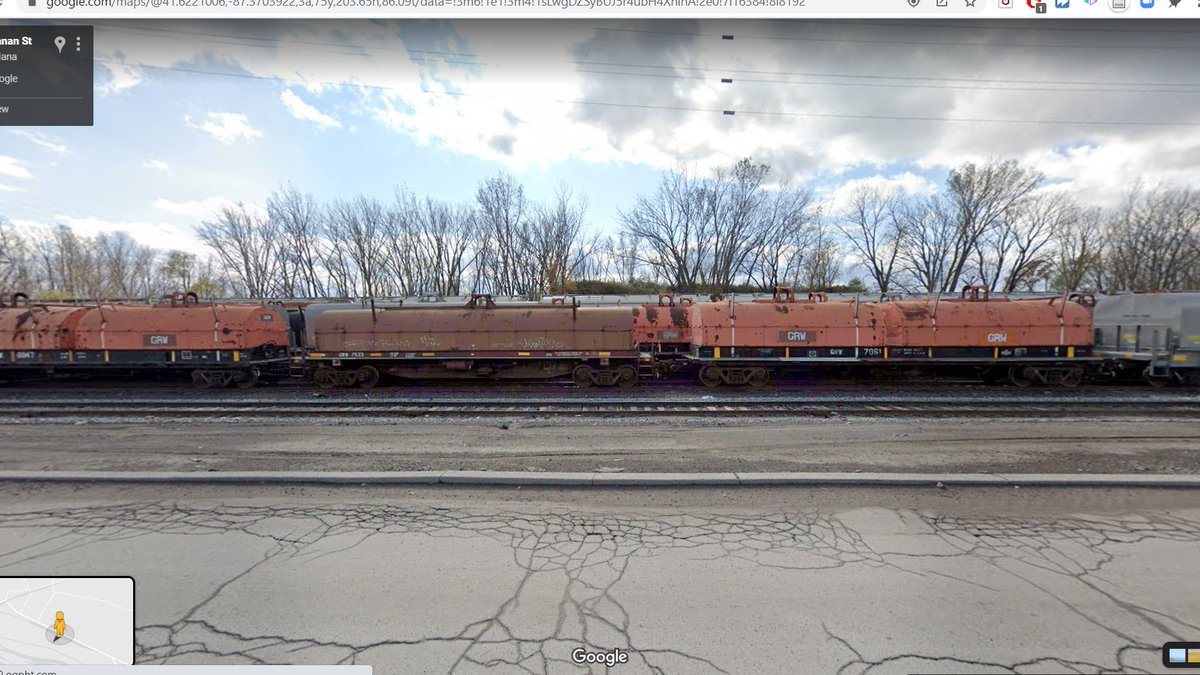
Crossing the Chicago South Shore & South Bend in Gary. The only US interurban to persevere through the years carrying passengers, and currently a hugely underutilized asset:

https://twitter.com/A320Lga/status/1285639035667578880?s=20

Paired 1 way streets carrying highways through mid-sized downtowns..really suck; they encourage dangerous speeds in (actually or potentially) pedestrian-dense areas. Here we are on the eastbound half of US-20 through Gary; the downtown is mostly gone, but you get the point. 

Foreground: CSS&SB line (the one we crossed earlier).
Backgrond: NS's ex-Conrail Chicago Line, their primary artery for freight traffic in and out of the region. Easily sees 60+ trains/day #SEANYC
Backgrond: NS's ex-Conrail Chicago Line, their primary artery for freight traffic in and out of the region. Easily sees 60+ trains/day #SEANYC

ArcelorMittal's Burns Harbor plant (ex-Bethlehem). This is the newest integrated mill (integrated = contains all equipment to make steel from raw iron ore vs melting from scrap) in the US, finished btwn '66-75 

Today, freight ops on the CSS&SB are done by a private carrier and are diesel, but into the 80s the line was a bastion of electric freight service. #SEANYC
flickr.com/photos/2955783…

flickr.com/photos/2955783…


Michigan City scenes (note the street running segment of the CSS&SB) #SEANYC 





Semi-rural highway interchange in progress, because this slip lane-d mess wasn't enough and our country seems okay with (literally) driving itself to climate emergency #SEANYC 



A steel finishing plant in a cornfield: truly the modern industrial landscape here #SEANYC 

South Bend's old Union Station. Amtrak still stops in the city, but does so at this Amshack about 1.5 miles west of downtown. Sad how a service that markets itself on downtown-downtown access has so often left downtowns through its almost 50 years. #SEANYC 



South Bend's downtown is yet another example of how cars have come to dominate urban space. So much of it is just parking. 


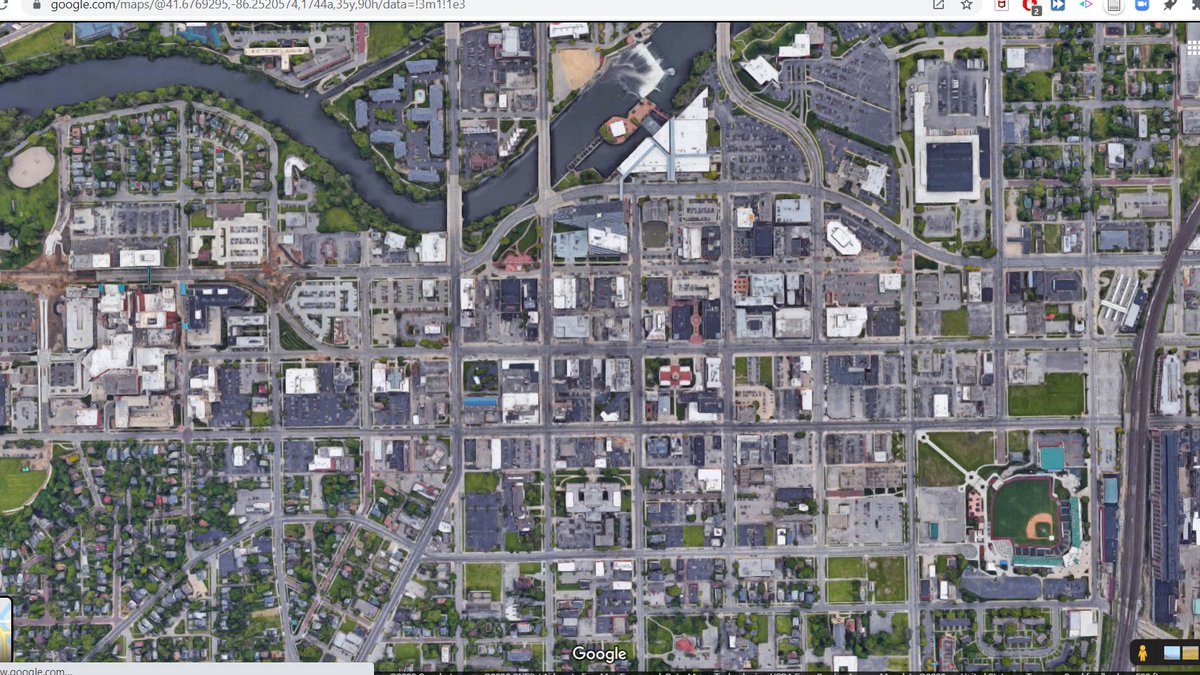
And this isn't just some urban renewal saga, either: in so many US urban business districts, decentralization trends meant that by the '30s, building owners were tearing down office space to make surface parking lots because they'd make more money that way.
Now/then. The evolution of the South Shore's route into the city reads like a history of bad transit planning: they abandoned the tracks into downtown in the 70s, cutting to the Amshack pictured above. And when it came time to 'revitalize,' they extended it...to the airport. 



(pic from:
upload.wikimedia.org/wikipedia/comm…)
upload.wikimedia.org/wikipedia/comm…)
Bittersweet Road #SEANYC 

Alongside Norfolk Southern's Elkhart Yard, in Elkhart IN. This (huge) facility is used to pre-sort freight moving through Chicago to western connections. As evidenced by the steel coil cars in the foreground, it also does a brisk business from Northern Indiana industries. #SEANYC 

A beautiful old truss bridge in Goshen. This type of modified truss is called a Pennsylvania truss, IINM. #SEANYC 

This segment of US-33 is part of the Lincoln Highway, the first transcontinental US road. Its construction was a key moment for the US's Good Roads movement, which itself gave way to the coalitions that brought us the highway and land use systems we live in today. 

It's an obvious point, but I do find this road's (and automobility more broadly) youth mindboggling -- begun in 1913, it's only 15 years older than my grandfather.
something something spend on road maintenance and not endless expansion something something #SEANYC 

Scenes of Fort Wayne, IN. Fort Wayne is an interesting example of an inland (and non-Mississippi) Midwestern metropolis whose growth was initially fueled by water transport; the city's first growth spurt followed the completion of the Wabash and Erie Canal in the 1840s. #SEANYC 







(Last pic in the above is of the old International Harvester plant, one of the sites struck in the famous strike of 1979)
Fort Wayne's railroad geography is worth a note. It lies on two East Coast-Chicago main lines -- one owned by Norfolk Southern (ex-Nickel Plate RR) and one by a short line (Chicago Fort Wayne & Eastern, ex-CSX exx-Conrail exxx-Pennsylvania RR main). 

The latter, ex-PRR line was almost abandoned by Conrail in the 1990s, which caused the Capitol Limited and Broadway Limited, both of which used to stop in Fort Wayne, to be rerouted out of town in 1994. The line ended up being kept, and was allotted to CSX in the Conrail breakup
...to be used as a secondary Chicago-Ohio main line much in the way that NS uses the Nickel Plate (as well as trackage rights over the PRR) to relieve its ex-New York Central line through northern Indiana. CSX's main line ended up holding up well, so the route was sold to the CFE
when you've crossed into Ohio but maps still thinks you're in Indiana (see top left) #SEANYC 
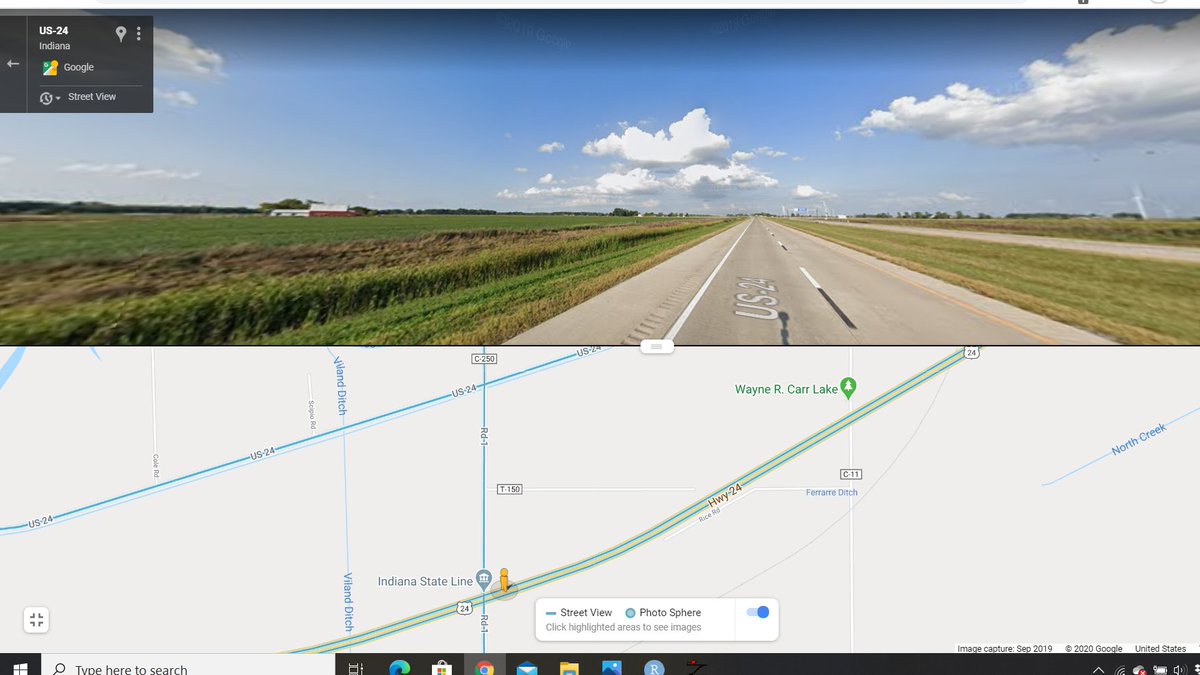
Crossing over the Napoleon, Defiance and Western (ex-Wabash). This line is widely regarded as having among the worst track conditions of any non-spur line in the US -- look at those squiggles! 

Realize I haven't done one of these in a while. Progress over the past week (give or take) has been poor, but such is life. For those interested in timeline, I'd say we're probably 14-20 days away from completion. #SEANYC 

An ancient Wabash color light still stands protecting where the Napoleon, Defiance and Western crosses CSX's main line in Defiance. Old signals like this are getting much rarer with PTC (which, to be clear, I think is a good thing) forcing replacement. #SEANYC 

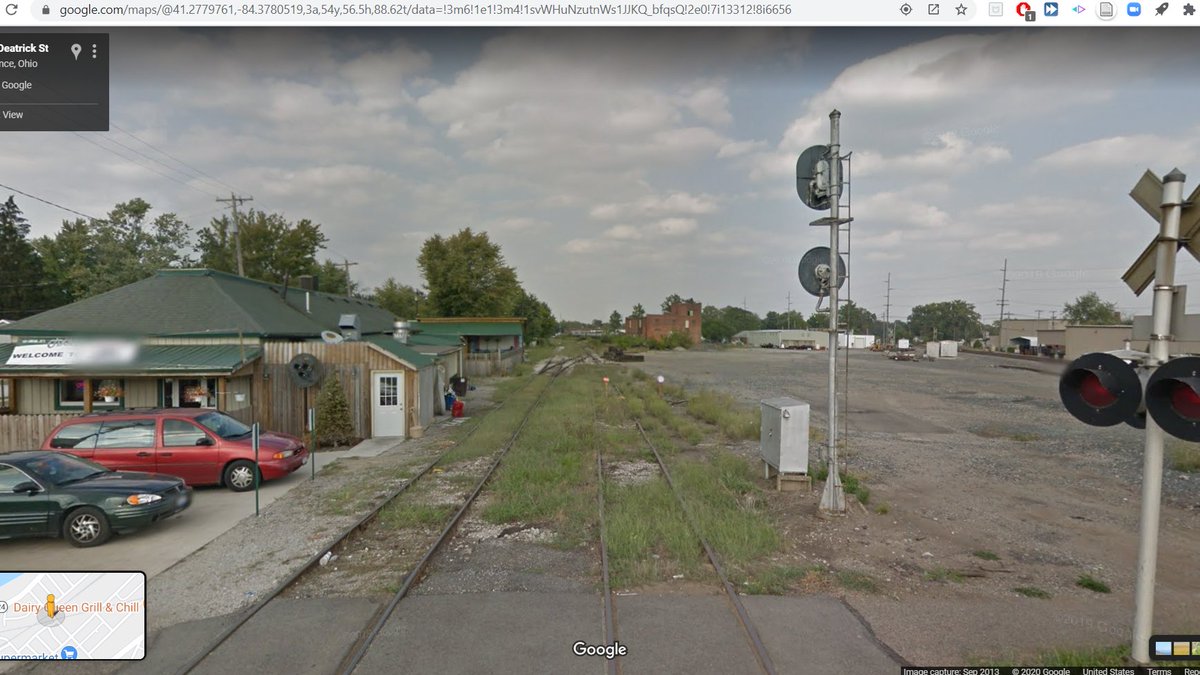
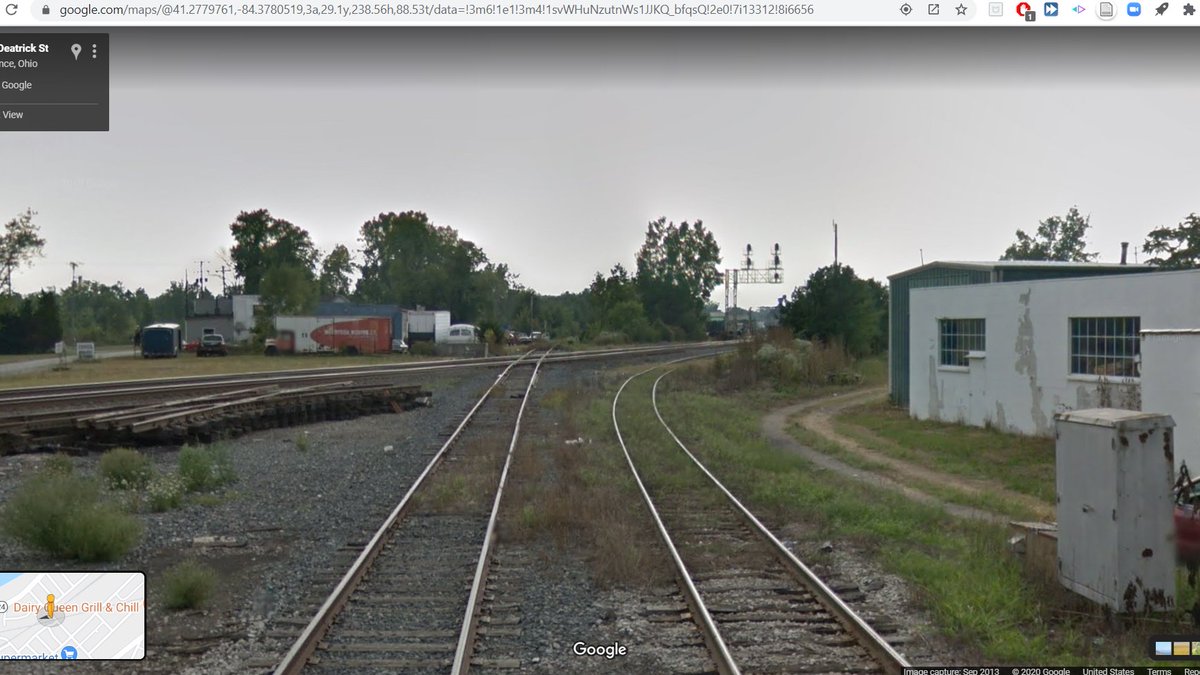
Train was here. #SEANYC 

Can't be certain absent higher res imagery, but this looks like a soy field. I've always found it interesting that US soy production is significantly more east-biased than are corn or wheat. #SEANYC 







Some details on the above signal
https://twitter.com/maxdiamondny/status/1289040501174304768?s=20
You'd never know it, but this area of OH was once a swamp the size of CT. Though its drainage has increased arable land, the loss of its natural filtration for Lake Erie, and its water's replacement with agricultural effluent has played a huge role in Lake Erie's algae issues. 



While we made progress in reducing runoff from point sources ringing the lake (think: industry) after the Clean Water Act, these sorts of non-point sources weren't rigorously regulated & are now regarded as being the biggest polluters.
(Img from: upload.wikimedia.org/wikipedia/comm…)
(Img from: upload.wikimedia.org/wikipedia/comm…)
Toledo is another one of these zero-growth sprawl metro areas. Deindustrialization hit it hard, and all sorts of...questionable planning choices only fanned the flames, for example the road below.


https://twitter.com/A320Lga/status/1287181673734590464?s=20


Dorr St once was Toledo's Black business district, but in the 70s it was deemed blighted. They elected to widen the street and clear much of the activity along it (seemingly w/o much effort to replace), yielding the above. toledoblade.com/local/2015/04/…
Wanted to leave this pithy quote from the above article for your consideration: #SEANYC 

Toledo is also another example of a Midwestern city that first grew up around a port; it was the head of the Wabash and Erie and Miami and Erie Canals. A decent amount of port activity still exists; mainly coal traffic and ore to inland steel mills. #SEANYC 

A nuclear station along the shores of Lake Erie. Aside from ports, nuclear power stations must be among the pieces of infrastructure most strongly correlated with proximity to large bodies of water thanks to their cooling needs. #SEANYC 

The Norfolk Southern coal pier at Sandusky. This terminal (which was built by the Pennsylvania RR, but made its way to NS ownership not via Conrail, but by Norfolk & Western's acquisition of this PRR line in 1964) ships coal largely to Great Lakes steel mills, IINM. #SEANYC 

One of the more deeply frustrating realities of US railroading is that, despite railroads' natural environmental advantages, they tend to be (quiet) fossil fuel proponents. Their wish to milk fossil fuel transpo assets such as this are one of the reasons why. #SEANYC
NS's Bellevue Yard. Until just a few years ago, NS was investing massive sums in expanding this facility to consolidate classification at a key network node. From 2015 to 2020, it was the second largest yard in the nation! But as of this June, most of the yard is being closed. 

I'd imagine there are a number of reasons driving this (perhaps most prominently that other somewhat-nearby yards all originate lots of local traffic as well as sorting through freight), but the yard's closure is nevertheless a testament to changing freight rail ops in the US.
For shipments that not large enough to fill an entire train, moving large volumes from yard to yard and continually resorting was once the norm. Now the emphasis is on avoiding yards by combining traffic that once ran in dedicated trains w/ small shipments...
...and pre-sorting cars (allowing blocks of cars to be easily swapped at intermediate points) wherever possible. This mirrors changes in the European network, where small shipments (what they call single wagonload) is being mixed with intermodal or unit trains in mixed trains.
Some interesting ecclesiastic architecture in Huron, OH #SEANYC 

Looking into US Steel's Lorain facility. Is part of their tubular products division, and has been for a long, long time. Steel is another large industry whose fate is deeply bound to the fossil fuel economy given the importance of auto/oil/gas in steel consumption. #SEANYC 

It's not crazy to say that the fracking boom (and requisite ^ in pipe demand) is what saved the steel industry from total disaster during the 2008 Recession, but as of March the facility is idle; tying one's fortunes to oil/gas leads to quite the production swings. #SEANYC
Did someone say job sprawl? #SEANYC 

Population sprawl -- your subdivisions depopulating central cities -- is generally the target of anti-sprawl advocates, but job sprawl is generally more damaging insofar as it is *really* difficult to build transit use in polycentric regions. #SEANYC
Piling upon Cleveland's job sprawl issues is what's happened to transit service in the city. During the Great Recession, the city lost about 35% of its transit service-miles, and has never completely got them back. #SEANYC 



Some positively ancient 3-bay coal hoppers in front of Arcelor Mittal's blast furnaces in their expansive Cleveland Works (mostly ex-Republic Steel). #SEANYC 

I've made this point before, but it's difficult to separate the decline of the steel industry from the fact that *so many* plants were located on these sorts of highly constrained (and urban) river valley sites.
Squeezing new processes into those plants was difficult, and just didn't make sense in many cases given the incentives to transfer operations (or cede market to) to more rural operations.
Old plants (and old companies) were also at a disadvantage given the highly adversarial nature of steel industry labor relations. Largely thanks to the huge influence Taylorism had on 20c HR practices, the US steel industry suffered hugely from mgmt-labor distrust through the 80s
It's difficult to overstate how bad this was. The legacies of lagging tech spending and sclerotic practices presented the industry with a massive collective action problem during the early 80s; to weather the recession and foreign/minimill competition they had to ^^ productivity.
(minimills being smaller steel mills fed by scrap metal that could generally produce steel at lower cost than integrated -- iron/coke in, steel out -- producers. they became important players in the lower segments of the steel market during the 1970s)
What roles labor/mgmt/gov't would play in that story would be contestatory in the best of times (esp. given the reality that some plants would have to close), but the bad faith assumptions that abounded made things oh-so-much worse...
I could go on about this for a while, but to bring us back to Cleveland, the net effect of this paralysis was that the geography of steel production that remained in the US looked radically different than it had before the 80s
Gone were many of the urban mills in PA/OH/NY; the ascendant mill typology was rural, Southern/Southwestern, and non-union. The wholesale disappearance of these types of work has a lot to do with the urban poverty we see in cities like Cleveland today. 

To some extent, this shift reflected shifts in demand (ex: oil production moving south/west), but it also was the product of various sorts of arbitrage/subsidy -- on labor rules/costs, tax rates, transportation costs and otherwise. #SEANYC
Steel mills frequently use exhaust gases from 'hot' processes to fuel other parts of the plant, which leads to quite the tangle, especially at larger facilities like in Cleveland. 

The age (rrs played an even larger role in steel production processes back when mills used ingot castings) and riverside site of the plant also means that its trackage is exceedingly complicated. You could catalog a _lot_ of railroad hardware just in these two photos! #SEANYC 



Perhaps more important than steel in Cleveland's early development was oil. When US oil production occurred mostly in western PA, Cleveland was _the_ refining center; Standard Oil's HQ was even here until 1911! Little remains of the industry today, it would seem. #SEANYC 

Cleveland's West Side Market, an old municipally owned market where one can buy foodstuffs from a wide range of vendors. H/t to @FdlGe7 for this location. #SEANYC 

Cleveland's Tower City, a real estate scheme built w Cleveland's Union Station (bc TOD was the default option back then). CUS served both long distance trains and transit from the start--including the Shaker Heights route, which forms a backbone of GCRTA's network to this day. 

Sadly, job densities have declined significantly in downtown CLE since then; Cleveland Clinic seems to have more jobs/sq mi than downtown at this point. #SEANYC 

For ~a century, the fiercest rivalry in railroading existed between the NY Central and Pennsylvania railroads, competing for primacy in the Northeastern US.
The pride and joy of the NYC was their water level route btwn NYC and Chicago, a path which gave them a leg up on operating costs and speed vs the PRR, which had to deal with the Alleghenies. 

During the 1998 Conrail split, the route east of CLE was given to CSX, and west of it NS (to be used w/ the old PRR east of CLE). These signals are where ownership changes. One can only imagine the horror NYC executives would feel at their beloved line having been split in half! 

Scenes from University Circle and environs in Cleveland, that big job-dense area east of Downtown on the map from yesterday. This is where Case Western and Cleveland Clinic are. #SEANYC 





(And yes folks, the Euclid Avenue you see in pic # 3 above does indeed go to _that_ Euclid, the one involved in the Supreme Court case that gave us modern American zoning.)
...and here we are in Ambler heights, a turn-of-the-century 'garden city' type development by the real estate company that sued the town of Euclid in Euclid v Ambler. This area is (ironically) now a historic district. #SEANYC 

Along the Shaker Heights Rapid Transit route, the transpo instrument that facilitated the construction of the area's garden suburbs. This is a somewhat rare example of a US streetcar suburb that's kept its streetcar. #SEANYC 

The wide median, curving side streets, large lots and extensive vegetation here read like a textbook of Olmstead/Howard/Downing inspired garden city planning. #SEANYC 

I think this town, called Chagrin Falls, takes the cake for best place name on the trip (so far, at least). #SEANYC 

Progress update #SEANYC 

Apologies for the spotty posting over the past week. Have been busy. We resume our journey in Warren, OH, a steel town and a key junction point on your author's favorite fallen flag: the Erie Lackawanna #SEANYC 



This sad little bit of disused trackage was once the Erie Lackawanna main through town. In part because the EL main missed important population centers west of Buffalo, and in part because the EL was shotgunned into Conrail at the last moment, Conrail tore up a lot of EL assets. 

(for those of you not acquainted w/ Conrail, may I recommend american-rails.com/conrail.html)
The former site of Republic Steel's Warren Works, with an ex-NYC searchlight signal in the foreground. This mill marked the northernmost extremity of the Mahoning Valley steel district, which once contained a number of plants in/around Youngstown and Warren. 

To give you a sense of just how large the industry once was, each one of those reddish areas along the river in the middle of the pic used to be a (part of a) steel mill. The area was compared to Germany's Ruhr, but now only hosts one small operation. 

It's easy to decry the loss of these bits of industrial infrastructure, but the real story here is one of persistent disinvestment. I can't think of a country that's handled deindustrialization well, but...
...the US's almost completely uncoordinated response -- and its concurrence with the rise of intermunicipal competition for jobs and drastic reductions in federal level antipoverty programs -- have left deep socioeconomic scars.
These impacts have been especially felt by BIPOC workers, whose low seniority, lower physical mobility (intra and interregionally) and structural workplace disadvantages made their experience of deindustrialization especially difficult.
Pathologies of that sort create stark maps -- note here, too, that the narriative of industrial disinvestment must be overlaid with suburban flight! #SEANYC 



A cool Art Deco-y building in Niles. #SEANYC 

McDonald, OH, a company town built for US Steel's McDonald Works. This was a relatively late-era company town (20s-ish); note the single family housing typology, which served both as an amenity for workers and a tool to encourage stable mill employee families to settle. #SEANYC 

Left turn lanes but no clearly delineated crosswalks or yield signs for pedestrians, in a city where 17% of people don't own cars (which, for reference, is more than in Staten Island). You really hate to see it. #SEANYC 

A Ukrainian (?) church in Youngstown. Lots of E European immigrants ended up in steel towns in the early 20th century, before we passed a number of xenophobic immigration restrictions. #SEANYC 
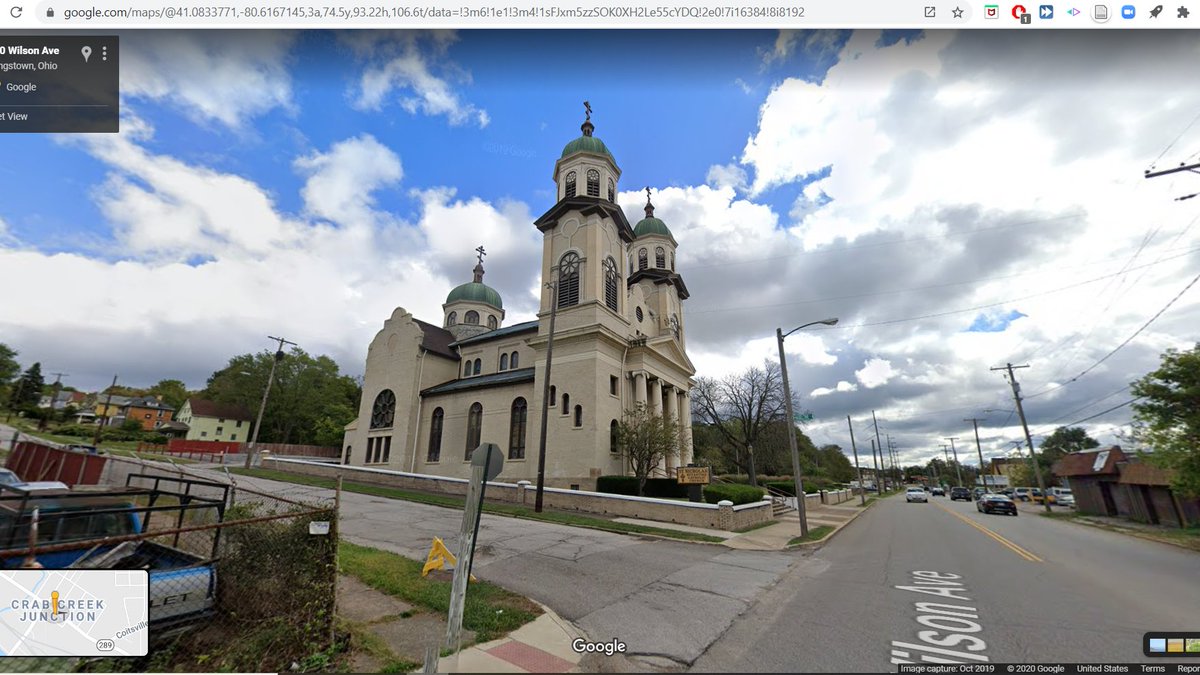
The ex-site of the Campbell Works, which was among the first major steel mills to close in the Midwest on what's known as Black Monday in 1977. Took only 10 years for the most others which would close to call it quits as well. #SEANYC 


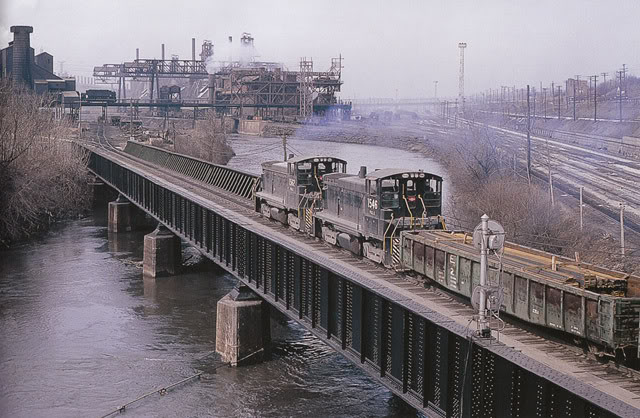
Quick aside before I begin tonight’s leg: I was browsing a book on the B&O today when I stumbled across this image, of a transfer freight heading to the Campbell works on 9/15/77. That’s **four days** before Black Monday. Spooky. 



Goodbye Ohio and hello Pennsylvania! This will be the antipenultimate state on the trip -- we're getting there! 

A B I G slip lane, because it's important that drivers can take this intersection at 60 or w/e #SEANYC 

I always find it fascinating to look at small cities' demographic patterns. New Castle, PA, despite having lost about half its population and most industrial employment, still contains a well defined employment core which employs about 10% of the county's workforce. #SEANYC 



These sorts of small-city downtowns were tiny enough that they could (sort of) persevere into the age of the automobile despite the geometric limits of automobility in dense settings. It's an interesting mix: an autoscape with pre-automotive employment patterns. #SEANYC 

While the big integrated mills are mostly gone from the Ohio/Mahoning/Monongahela valleys, there remain a relatively healthy number of metalworking and steel finishing operations in old mill buildings/on old mill sites. #SEANYC 

A beautiful example of a Pennsylvania Truss bridge in...Pennsylvania! #SEANYC
pahistoricpreservation.com/wp-content/upl…

pahistoricpreservation.com/wp-content/upl…


In an area once dominated by the steel industry (with an extremely healthy glass and ceramics industry alongside it), fire bricks once were a huge business. To this day, there are areas of steel mills that need to be relined about once a month. #SEANYC 

CSX's New Castle Yard. This once was a somewhat important point on the B&O, staging traffic for area industries and for forwarding on trains heading towards Buffalo or Rochester via Butler. Use today is ~ the same, except the line towards BUF is owned by the Buffalo & P'burgh. 

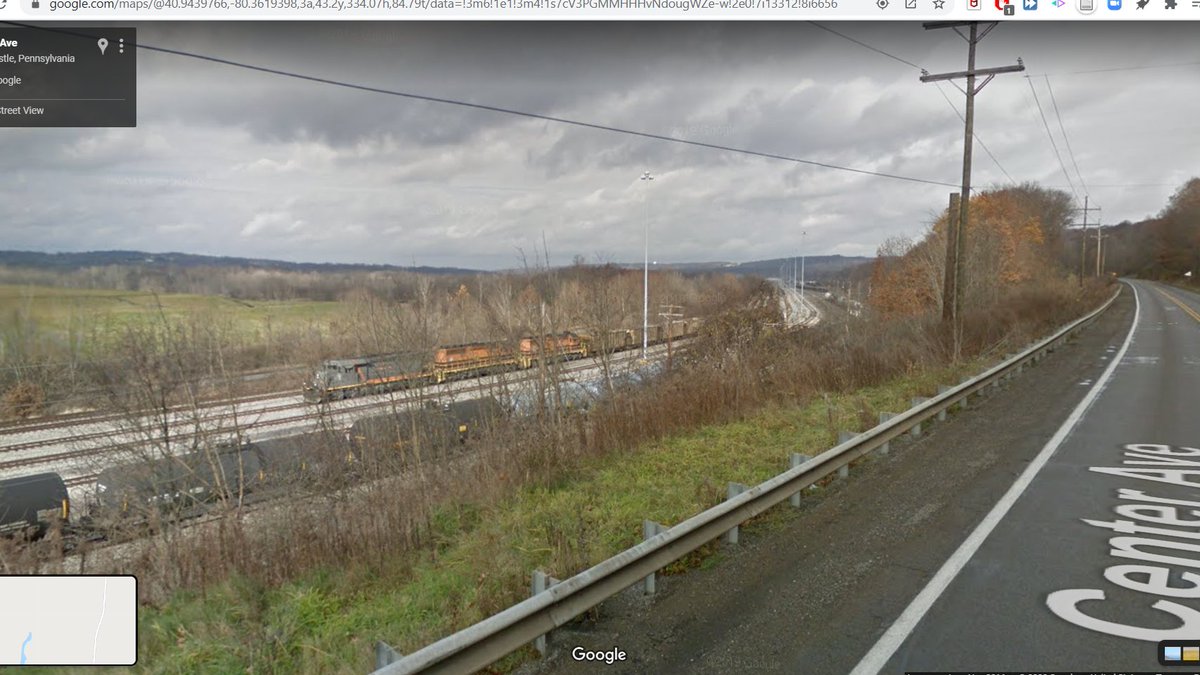

(map from upload.wikimedia.org/wikipedia/comm…)
One facet of the resource geography that made Pittsburgh such an attractive place to locate steel mills is hinted at by the presence of this cement plant: western PA is rich in high-grade limestone, which is used in steelmaking as a flux to remove impurities. #SEANYC 

A less well known steel operation in the Pittsburgh solar system: Tenaris' Koppel tube plant (ex Babcock and Wilcox, which used it in part to manufacture steel components of nuclear reactors). Built in 1959, it also is among the newest mills to have existed in the region. #SEANYC 

Because of its late build date, this plant has always used electric arc furnaces to make steel, EAFs being a mill technology whereby scrap is melted down and refined (in a single step) to make new steel.
This contrasts with the 2 step blast furnace => basic oxygen furnace process used to make steel from iron/coke/limestone, which was the dominant steelmaking technology before the 1970s and was, consequently, the tech of choice at most Pittsburgh mills. #SEANYC
Beaver Falls, PA #SEANYC 



Scenes of New Brighton, PA. Note the alley urbanism (of which I'm a big fan!). Last pic shows the grade separated junction between Norfolk Southern's ex-Pennsylvania RR Youngstown and Ft Wayne lines. The former goes to Ashtabula via Y'town; the latter is the mainline to CHI. 





Sheetz vs Wawa: the quintessential Pennsylvanian divide (I'm a NYer, but am 100% team Wawa) #SEANYC 

Who needs San Francisco when you can go to PA river towns and see tons of steeply sloped streets #SEANYC 

Conway! This massive ex-Pennsylvania RR facility lay at the heart of their network (as this graphic from a 1957 pamphlet shows) in the industry-rich P'burgh area, and has remained an extremely important yard for successors Penn Central, Conrail and Norfolk Southern. #SEANYC 



Freight here is classified by humping cars, so pushing them up a hill, uncoupling them, and then routing them to roll down the other side of the hill into a track containing cars for a given destination. Conway used to have two humps -- one for e/b traffic, one for w/b...
...but after receiving their portion of Conrail, NS shut one of the humps and transferred some duties to other yards, including the facility at Bellevue which we covered a few weeks ago.
Ironically, Bellevue is now closed while Conway remains open; the volume of traffic that still is generated around P'burgh and its enduring network logic would suggests to me that it won't go anywhere, but I don't wanna jinx it. #SEANYC
Pamphlet: multimodalways.org/docs/railroads…
Looking north at the former site of Jones & Laughlin's Aliquippa Works. Production here ended in 1987, only six years after the first steel producing section of the plant shut. Timeline from: books.google.com/books?id=eb6Js… #SEANYC 



I could bore y'all for hours talking abt the mill, but want to note what is by far its most lasting contribution to industry. In 1937, SCOTUS ruled that workers fired for unionizing at Aliquippa had to be reinstated, thus upholding the constitutionality of the Wagner Act. #SEANYC
Across the river from Aliquippa is Ambridge, a company town for the American Bridge Co. The ABC was less of a bridge company--though it did make lotsa bridges--and more of an enormous steel plate/girder fabrication outfit; they worked on skyscrapers, for example, as well. #SEANYC 

Garden apartments like these have gotta be one of the most ubiquitous multifamily housing types around. You find tons of them in inner-ring suburbs in the NE/Midwest. It's good that they're multifam -- that's progress for the burbs -- but the lot sizes and FARs are very meh. 

Like, the houses at right and these little apartments at left have...basically the same footprints. This probably makes it easier to get such developments by local permitting authorities, but it leaves a ton of housing capacity on the table. 

Hey look, it's NYC's finest export! This is 63V, a solid train of garbage that runs from Kearny (with an additional stop at Bridgewater) to Mingo Jct, OH, where a shortline railroad takes the lovely stuff to a nearby landfill. #SEANYC 

From time to time, the highway-industrial complex produces a very pretty bridge. I'm a sucker for suspension-arches. #SEANYC 
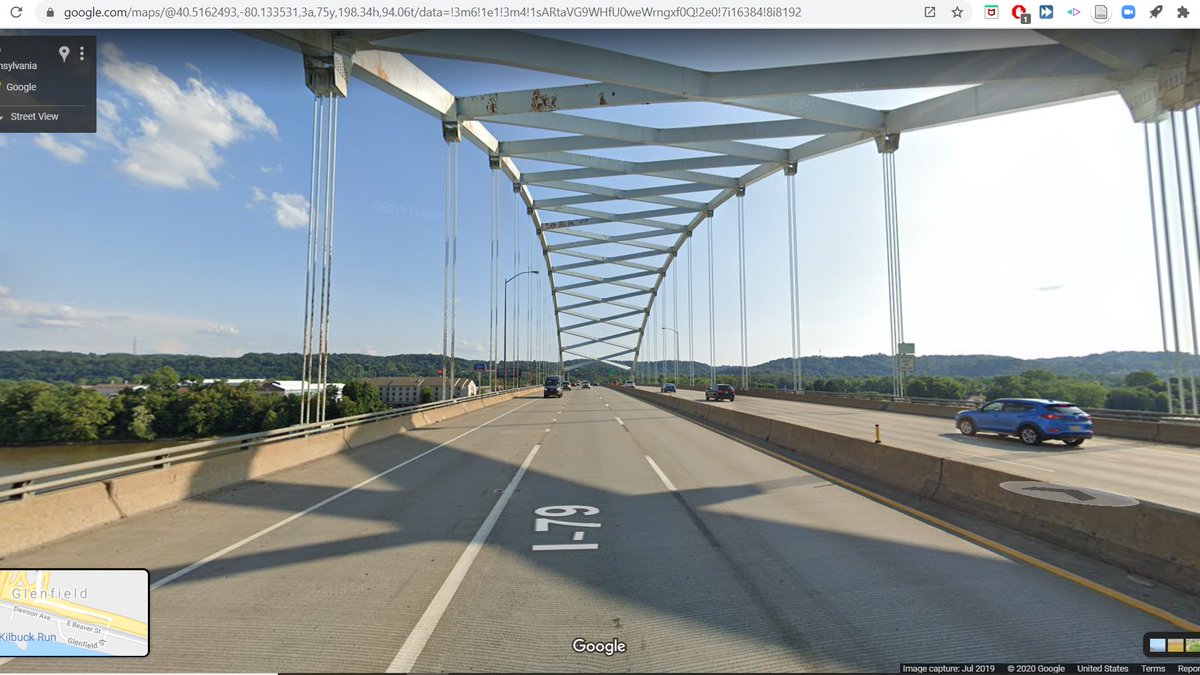
Seems Pittsburgh has also caught onto the "cheap hotel construction in industrial borderlands" trend #SEANYC 

Neville Island, north of Pittsburgh, once hosted a large shipyard which made barges for inland transport. It closed in 1983, and its old ramp now *seems* to be in use as a site for barge dismantling by a scrapyard. #SEANYC historicpittsburgh.org/islandora/obje… 



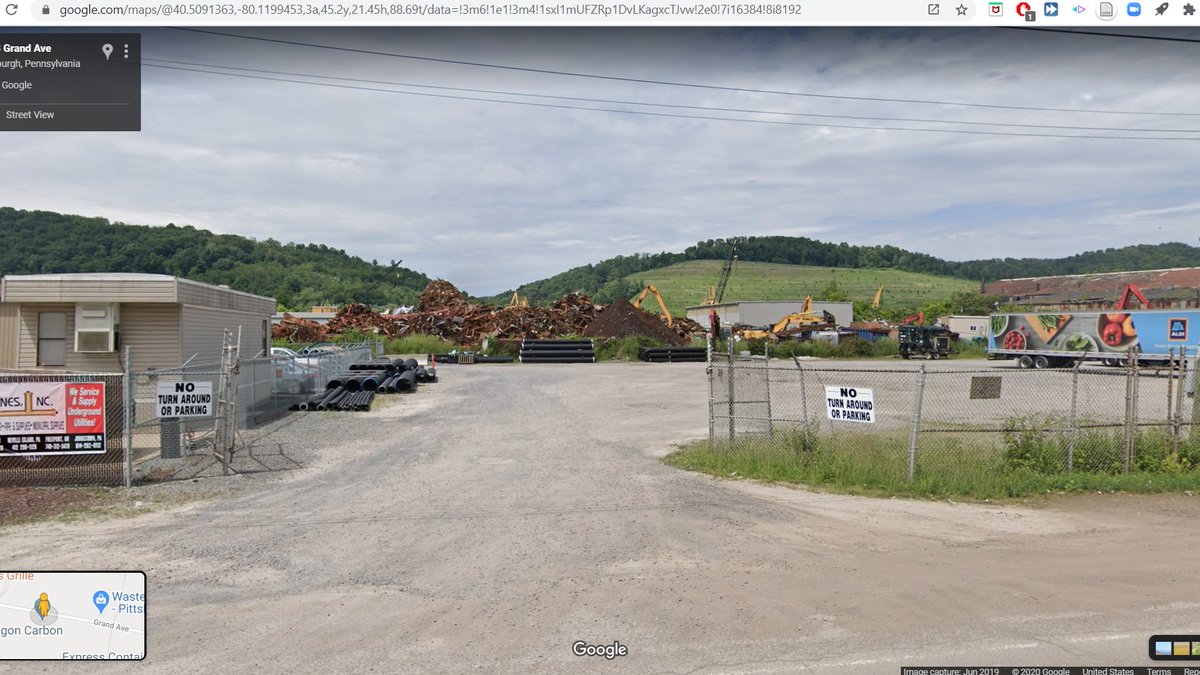



This facility was once a coke works, where coal is baked to drive off impurities. This facility (and others like it in the PGH area, including the still-operating Clairton Coke Works) had long been the source of a massive amount of air pollution
appvoices.org/2018/06/07/hea….
appvoices.org/2018/06/07/hea….

Much as (and this is esp. true of first-wave gentrifiers) gentrifiers have a tendancy to uncomplicatedly idealize the neighborhoods/eras during which they gentrified, the narrative of industrial plenty is one that deserves some nuance. This is Donora during the smog in 1948: 

The north end of Norfolk Southern's Mon Line are those two tracks that rise up here. This ex-coal/steel route has found a second life as NS's double stack cleared route through Pittsburgh, as stacks cannot fit through downtown on the Pittsburgh Line. #SEANYC 

Some lovely mansard roof houses on a hill in the North Side #SEANYC 

Some views of Allegheny Center, one of Pittsburgh's many urban renewal projects. From the 1940s until the '80s, Pittsburgh's government worked closely with business (largely through the (in)famous Allegheny Conference) to enact one of the more extensive renewal programs in the US 





The profile of Pittsburgh's projects was unremarkable among others in the US (highways, downtown refreshes, new tower-in-a-park housing), and was equally unremarkable in its regressive impacts (ex: Lower Hill District, E. Liberty). #SEANYC
As @sandypsj would note, regressive, auto-centric infrastructure was not necessarily unpopular infrastructure -- important context for modern discussions which cast urban renewal as an aberrant technocratic imposition -- but it nonetheless has been...quite bad for PGH. #SEANYC
In part thanks to those urban renewal efforts, Pittsburgh retains a strong CBD. #SEANYC 

While Pittsburgh may go down in history as a steel and railroads city, its geography was indelibly shaped by rivers: it's no accident, for example, that all the mills located on the Mon and Ohio rather than the Allegheny; they were directly downstream of the S PA coal seams
The beginning of the Pittsburgh LRT tunnel, placed (lol) under a parking structure. Here, as in Saint Louis and Weehawken, old railroad tunnels got rebuilt to serve as grade-separated transit rights of way -- in this case, part of the old Panhandle tunnel. #SEANYC 

Before this tunnel was built in the 80s, Pittsburgh's downtown had quite the network of surface rail trackage; Pittsburgh generally was an outlier in that it retained large portions of the streetcar network into the 1960s. #SEANYC transitguru.info/pgh/history/pd…
S L O P E #SEANYC 

The Hill District, yet another American neighborhood scarred by racially tinged disinvestment and urban renewal policies. Also another neighborhood that has, in the span of 70 years, witnessed the construction, demolition and replacement of public housing. #SEANYC 

More so than other postindustrial Midwestern cities, Pittsburgh has managed to remain a relatively important economic hub. It owes much of that success to its universities, which helped attract/retain '21st century' industries. #SEANYC 

...but this prosperity has not been, by any stretch of the imagination, shared. Pittsburgh's resurgence essentially has created a class of post-industrialites who aren't much better off than in most other Rust Belt cities + a separate/prospering white collar world. #SEANYC 

An entrance to Pittsburgh's East Busway which, a la Ottawa, is the trunk for a number of feeder branches. It uses two of the four former trackways along the PRR main line into PGH. This short entrance to it follows the ex-B&O main line as it exits Schenley Tunnel. #SEANYC 

Shadyside #SEANYC 




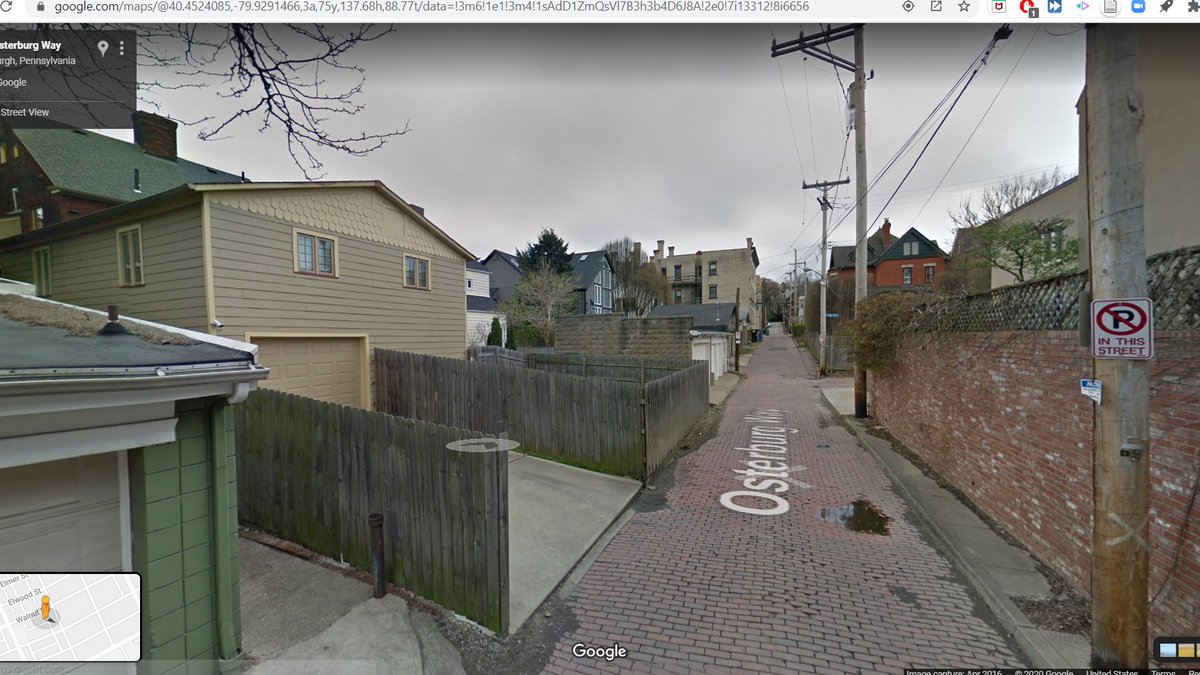
Site of J&L steel's Pittsburgh Works. This side of the river housed the plant's blast furnaces; coke/ore/lime etc was made into molten pig iron here, put into torpedo cars and then was moved over the Hot Metal Bridge to the open hearth furnaces and rolling mills in the South Side 



Above pic is from:
brooklineconnection.com/history/Facts/…
brooklineconnection.com/history/Facts/…
Hazlewood -- the neighborhood the old J&L works in Pittsburgh. The neighborhood is a food desert, a reality all too common in US cities, and one that only reinforces the need for high-quality (and non-radial) public transit so as to minimize the penalties of distance. #SEANYC 



WJ Tower, which once controlled the east end of the Baltimore and Ohio's Glenwood Yard. #SEANYC 

The trackage around the tower tells a transport story of industrial decline: the line that once went from here to Wheeling is now severed, the yard itself is now a secondary/tertiary facility, as is the original B&O main line that brought trains to it from the north. #SEANYC
Pic 1 is the former USS Homestead Works. Yes, *that* Homestead, the one of strike and Pinkerton fame. Much like the J&L Pittsburgh Works, the Homestead Works had two parts: its furnaces were across the river at Carrie Furnaces (pic 2). #SEANYC 

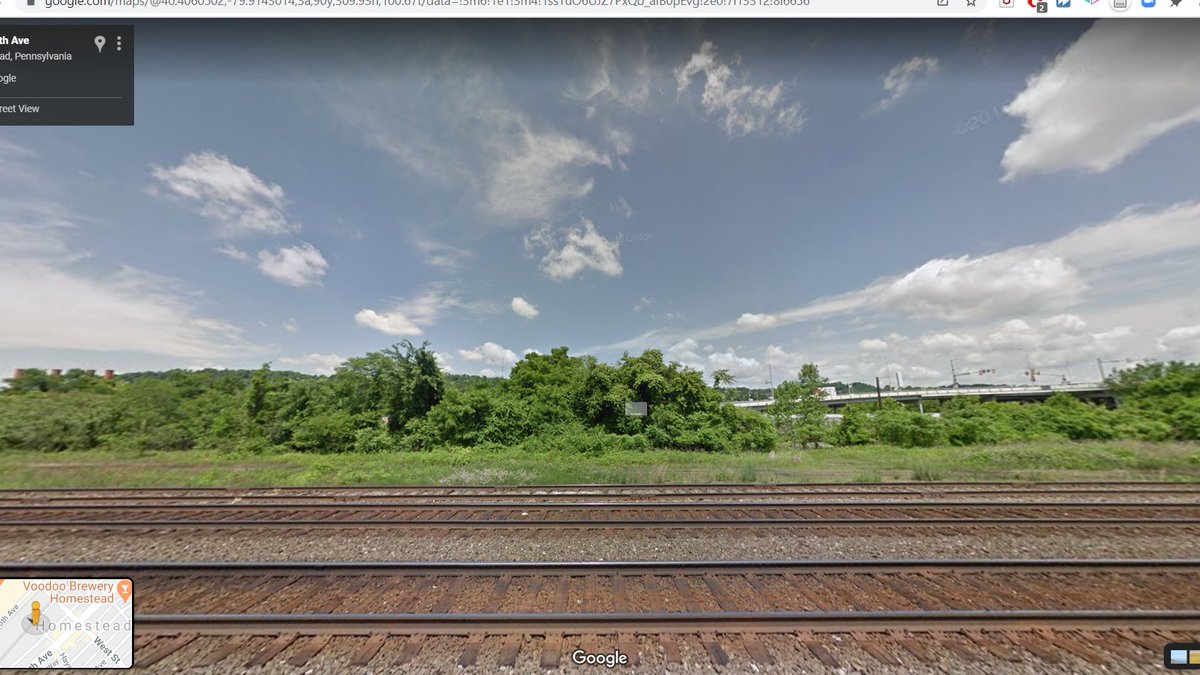

The last integrated mill in the Mon Valley is the Edgar Thompson Works, which itself is one component of a larger complex of 4 plants -- 3 in Pittsburgh, and one north of Philly in Fairless. 

The story of ET's survival is...interesting. On top of the labor relations (constricting work rules, Taylorist zealotry, adversarialism) and geographic (demand was shifting west, urban river valleys constrain expansion) factors at play in the demise of Rust Belt mills...
...was a huge lag in US producers' uptake of steelmaking technology. While the Japanese and Germans had spent the '60s and '70s installing basic oxygen furnaces and continuous casters -- labor/time saving and qual. improving techs -- US producers, despite no shortage of capital..
...had done little to move beyond open hearth furnaces and ingot casting, and indeed built greenfield integrated steel mills (ex: Bethlehem's Burns Harbor plant) without those technologies.
It's easy to armchair these sorts of qs now, but what IMO (and in the opinion of a number of researchers jstor.org/stable/2097927) is telling is that these technologies were actually adopted in the US--but only by smaller producers. Institutional conservatism is one helluva drug!
Anyway, when the 1980s rolled around and the industry was in crisis, USS knew that a) it would have to choose one or two of its Mon Valley plants to keep open/invest in and b) that everyone wanted their mill to stay.
In their eyes, ET was the most modern of their mills (despite being the oldest in the valley), but they still did a little deindustrialization arbitrage in playing the valley's many municipalities off each other for tax benefits.
They briefly considered keeping part of the Duquesne works (one town downstream & with a much ^ steelmaking capacity) open w/ hot metal shipments to the plant (a la Homestead) but the cost of doing so > benefits, so it was nixed. Et voila, ET survives. #SEANYC
That the Mon Valley was, governmentally, so fragmented is really a legacy (of steel production -- some of that was for the tax convenience of producers) that haunts the Valley to this day. It stood in the way of coordination then, and it still does now
Mckeesport is very urban renewal-y. During the '60s and '70s, the little city did legitimately try to 'improve', implementing an unsuccessful pedestrian mall, moving the B&O mainline out of downtown (the CSX train at right is on ex-P&LE rails) and building lotsa parking. 

In essence, the city tried to convert its historically transit- and walking-oriented downtown (streetcars and a 10k+ strong local employer will do that) to look like one of the shopping malls around it and...it didn't work.
Given the land use/transpo/funding incentive system within which they worked, I'm honestly unsure of what they could have done *differently* -- rather than just less of. Small CBDs like this were doomed in the auto age. #SEANYC
*inching* towards NYC #SEANYC 

.@akgerber successfully goaded me into making a southwards bend, so we're making a detour down to Morgantown WV, aiming to resume normal route back at Johnstown #SEANYC 
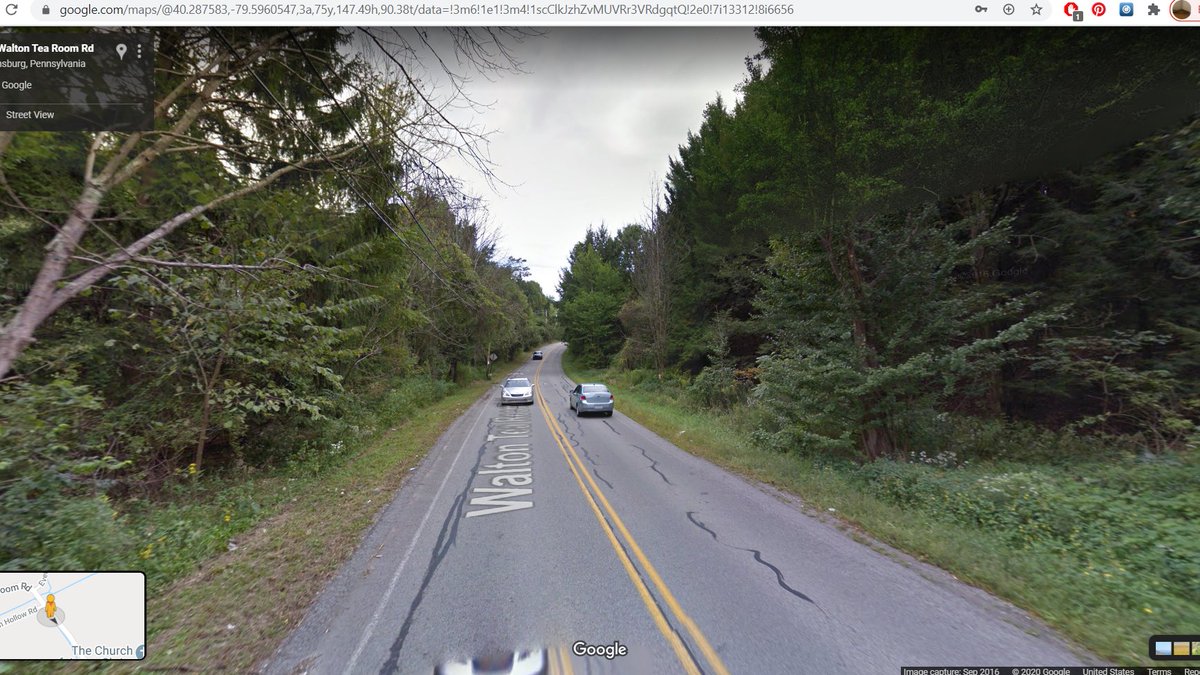
On one of these mountain-defying highways. Geographic aesthetics aside, road building really transformed the jobs geography of river towns: post-highways, industry/employment had an unprecedented ability to sprawl away from valley sites/routes.
https://twitter.com/mtsw/status/1294087174766247941?s=20
Some of the stuff seen yesterday in McKeesport is just that: malls (and office/industrial parks) in the Mon Valley wouldn't have been nearly as possible if activity had been constrained to rail/water-proximate valley sites
Another good image of this topographical freedom issue. I-70 can just go over hills and soar across valleys, while the railroad has to studiously (and slowly) follow the Youghiogheny below. #SEANYC 

These bridges carry the Wheeling & Lake Erie railroad towards its gigantic bridge over the Monongahela (pic 2). The left bridge goes to the lower bridge in the second pic, which descends into the river valley to serve Monessen -- another ex-steel town. #SEANYC 



The W&LE has an interesting history. It was once part of the Alphabet Route -- a group of small eastern/midwestern railroads offering an alternative to the main Chicago-NYC carriers -- but ended up in the control of the Norfolk and Western. NS sold most of its lines in 1990... 

...to create a new railroad called -- wait for it -- the Wheeling and Lake Erie. #SEANYC
graphic from en.wikipedia.org/wiki/Alphabet_…
graphic from en.wikipedia.org/wiki/Alphabet_…
One of the locks/dams along the Monongahela. While much less glamorous than ventures such as the Erie Canal, the damming of rivers such as the Mon was really what made inland water transport viable -- no more portages! 

Monessen PA is a great example of the linear river city downtown. In terms of the forms created, I must say I really appreciate the constrained urbanism practiced in places like this. #SEANYC 



The coke works in Monessen. Last active bit of the former Wheeling-Pittsburgh mill that once employed thousands here. Now operated by ArcelorMittal, the world's largest steel producer. #SEANYC 

The constraint products of riverbank development really show here. For a place that peaked at just over 8,000 people, Brownsville is quite a vertical place. It has some interesting typological peers growing along the Yangtze around the Three Gorges today. #SEANYC
(among other places, ofc)
A completed segment of the Mon-Fayette Expressway, the latest and greatest in regional economic development initiatives for the steel valley. This project is quite galling; as @liameoconnell notes, this Mon Valley has settlement/transpo structure patterns conducive to transit. 



(on top of what Liam said, all these towns have once-dense cores abutting the river and RR ROWs)
To be sure, I don't think transit is much more of a 'fix' for the region's multifaceted economic woes than highways, but at least it won't contribute to the sorts of urban disinvestment that have so hurt places like McKeesport, and won't accelerate climate change. #SEANYC
Southwestern PA produces a _lot_ of coal. Seams in this part of the state are generally high grade bituminous coal, making them suitable for metallurgical uses. Needless to say, this resource had everything to do with the prominence of Pittsburgh and Johnstown as steel centers. 

Even today, despite only ~10% of US coal production being devoted to metal production, >40% of PA coal production is metallurgical coal. A lot of that goes to export users, flowing through coal docks in Baltimore, Norfolk and Sandusky/Toledo to Europe and Canada. #SEANYC
Southern cultural connections in SW PA really show through in the prevalence of front porches on buildings here... #SEANYC 



Close enough to the mines that the bridges have these fenders to catch falling coal. #SEANYC 

The railroad that owns this bit of trackage, the Cumberland Mine Railroad, is among the more obscure isolated operations in the US. Despite being in a rail-dense region, it has no connection to the national network, acting solely as a shuttle from a mine to a barge terminal.
> Puts shiny sidewalk over new bridge
> Does not connect it to anything, creating a curb cut to nowhere
networks, people. networks.
#SEANYC

> Does not connect it to anything, creating a curb cut to nowhere
networks, people. networks.
#SEANYC
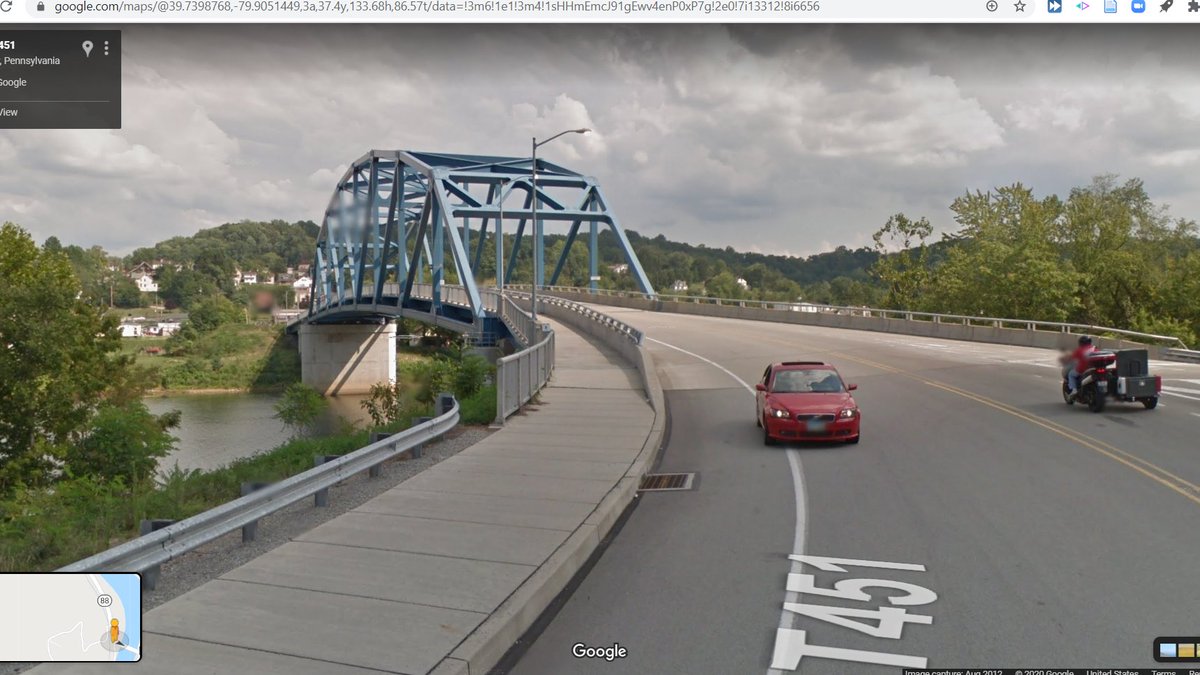

The confluence of the Monongahela and Cheat Rivers in Point Marion, PA. The Cheat is one of the east's more untouched watercourses, though it did fall victim to some acid mine drainage in the '80s and '90s IIRC. #SEANYC 

West Virginia! #SEANYC 

(no, I don't know what happened to the I in Jim or the actual welcome sign)
IDK how to classify these (rowhouses? multiplexes?), but based on past explorations of Appalachian cities, you seemingly see a lot of this in sorta-new multifam construction in the region. #SEANYC 

It's not *really* that distinct from your classic '60s-'80s courtyard or garden apartment development, just newer. I find their continuing prevalence interesting given the slow movement away from those typologies in other urban markets
The PRT isn't really a system. It's a single rapid transit line that runs these little 15 person cars along a line that stretches from Downtown Morgantown to the WVU campus pictured in the first photo above.
As per the _personal_ rapid transit model, the system is laid out to facilitate mixed express and local operations; each station has bypass tracks. In this regard, and in this regard only, the system sorta resembles the Shinkansen 🙃 #SEANYC
As I understand it, the PRT has three operating modes. In one, it acts as true demand response, collecting riders heading to the same destination and bypassing stops without passengers. In another, cars run fixed routes on fixed intervals. In yet another, cars just make all stops
At 2800 riders/route-kilometer (about on par with a busy bus route in NYC, for example the B6), it's a successful -- albeit white elephant-y -- bit of transit infrastructure for a small city like Morgantown. #SEANYC
For the first time....ever? I will be starting my daily streetview when the clock shows an AM value (that isn't like 00:30 or smth).
Currently enjoying some sidewalk streetview in Morgantown. More of this @googlemaps!
Currently enjoying some sidewalk streetview in Morgantown. More of this @googlemaps!
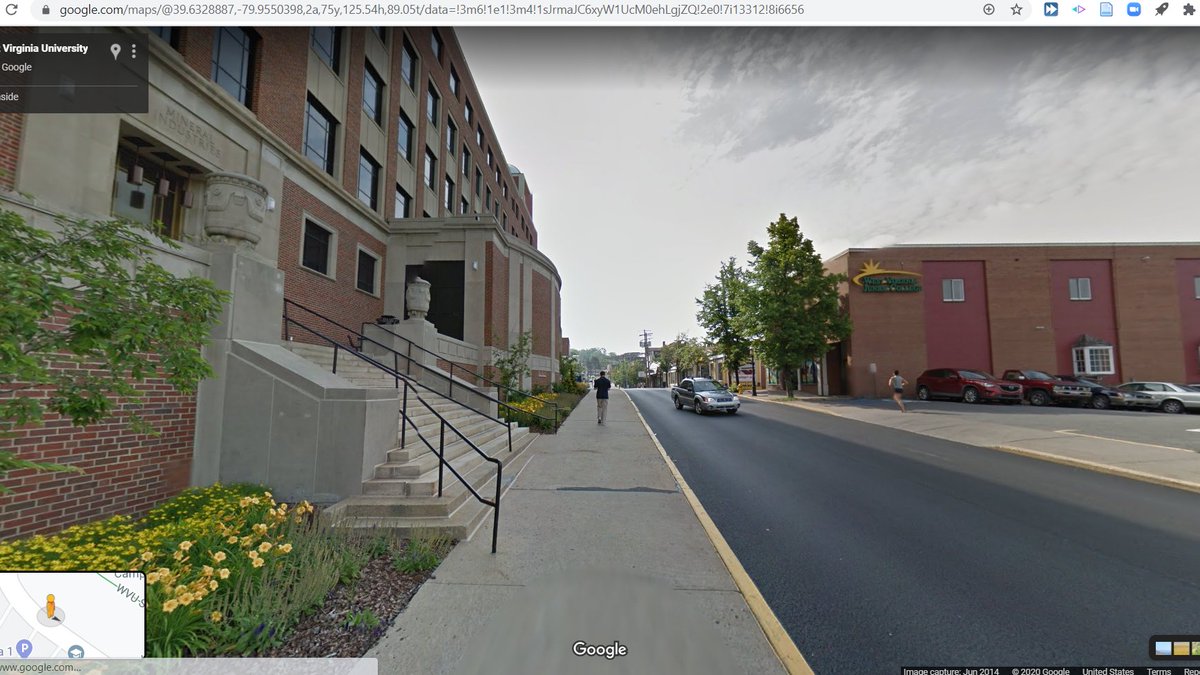
Some more Morgantown scenes. Once again am here to shill for Eastern river valley urbanism. #SEANYC 







Morgantown is an interesting case of a small city that, in part thanks to WVU, has been really successful in diversifying and weathering the downturn of regional mining/industrial fortunes. It's one of the few parts of WV that's experiencing population growth. #SEANYC
En route to Terra Alta, WV #SEANYC 

A lumber mill in Kingwood, WV. The forests of WV are the far northern end of the dense region of forest production that arcs south along the Appalachains to the Mississippi River -- a region which now makes up the lion's share of US forest production. #SEANYC 

This may just look like some boring double track, but what we're looking at here is actually one of the more important bits of railroad in US history: the summit of the Baltimore and Ohio's Seventeen Mile Grade. 

This segment is significant for two reasons: the first is that it was part of the B&Os original (1853) route from Baltimore, MD to Wheeling, WV -- a line which helped secure Baltimore's relevance and accelerated the development of Appalachian coal seams and the Midwest.
The second, perhaps more interesting significance is that the 17 Mile Grade's physical gradient (of 2.2%, or 116 feet/mile) became the standard for western railroads. The Pacific Railroad Act stipulated that first transcon's line profile match in quality the B&O... 

...a standard which was later adopted by the CP, NP, GN, Milwaukee and others when building their mountain crossings. #SEANYC
Actually making some progress now. Just so happens that I've basically done a big loop #SEANYC 



Lovely old bus in the MD pandhandle #SEANYC 

Back in PA. #SEANYC 

The ex-Western Maryland Salisbury Viaduct. The WM (like the W&LE covered previously) was a component of the Alphabet Route, and through this traffic + coal from WV, it remained prosperous throughout until its absorption by the Chessie System. #SEANYC 





Given how extensively the WM duplicated the B&O (another Chessie component), much of the WM was abandoned after the merger, including the trackage over this bridge. The ROW is now the Great Allegheny Passage trail.
img creds:
en.wikipedia.org/wiki/Alphabet_…
appalachianrailroadmodeling.com/arm2/wp-conten…
img creds:
en.wikipedia.org/wiki/Alphabet_…
appalachianrailroadmodeling.com/arm2/wp-conten…
The rise to the left of the train tracks in this photo is the remainder of the South Fork Hunting Club dam that collapsed and caused the Johnstown Flood in 1889. #SEANYC 

Among other effects, the collapse altered the way liability is treated in the courts. The club's escape from legal responsiblity for the disaster contributed to the shift towards a broader concept of liability, which included defective products/infrastructure. #SEANYC
For an exhaustive history of this movement, see PDF pages 26 and onwards here
digitalcommons.law.yale.edu/cgi/viewconten…
digitalcommons.law.yale.edu/cgi/viewconten…
Great view of Johnstown here. On the left, ascending the hill is the Johnstown incline, a funicular built two years after the flood to facilitate escape from the valley and to provide expedient transpo into the hills around Johnstown. 

It's part of the proud Pennsylvanian funicular tradition that began with the portage railroads associated with the state's Main Line of Public Works, and grew into passenger funiculars as seen here and in Pittsburgh. #SEANYC
https://twitter.com/RobtNS/status/1295199487980384256?s=20
As @RobtNS notes, Johnstown had a long streetcar tradition. They ran streetcar service until 1960 (!), and trolleybus service until 1967 -- service lives that exceed places like NYC, and certainly most other small cities.
A 1958 => present @ Market/Main


Much like New Castle, Johnstown (the darker area in the center of this map) retains a substantial share of its county's employment. Downtown Johnstown and the river valley heading south remain quite job-dense.

https://twitter.com/A320Lga/status/1291955320068222977?s=20

Yet Another Engineered American River. We really do love channelizing watercourses in this here country -- especially in the South, where the USACE and TVA were sorta allowed free reign. #SEANYC 

This was -- you guessed it -- a steel mill, Bethlehem's Johnstown works. The facility was built in 1898, but is notable in that it was built by the Cambria Iron Company which had pioneered large scale iron production in the US at their Johnstown works closer to downtown in 1852. 

Cresson, PA, another post-industrial town in the Northeast. Cresson also models the deindustrialization-prison expansion linkage; after the flight of industry, many towns turned to/became dependent on the expanding prison system for employment. 







This dependence creates a strong economic incentive for rural pols to oppose any movement away from the carceral state; navigation towards justice issue will have to grapple with this legacy. #SEANYC
(The prison in Cresson was SCI-Cresson, which closed in 2013)
Looking down over the portals of the Gallitzin and Allegheny Tunnels along the old Pennsylvania Railroad main line. The terrain here gives you a sense for just how exceptional New York Central's almost completely flat main line was/is.

https://twitter.com/A320Lga/status/1290501642685747200?s=20

Some details: Allegheny is fed by the tracks at left; Gallitzin was the grassy trackway at right. Gallitzin was abandoned (and Allegheny reopened) by Conrail when they cleared their main line through PA for double stacks in the 1990s.
Back when energy insecurity was _the_ topic of the day (so the late '70s), Conrail studied electrifying this stretch of the Pennsylvania main so that they could run electric freight trains from New York and Washington all the way to Pittsburgh.
The study indicated the economics made sense (though, oddly, it elects to exclude the train performance benefits), but the plan was shelved given the unavailability of capital and declines in oil prices.
railroads.dot.gov/sites/fra.dot.…
railroads.dot.gov/sites/fra.dot.…
(This was also important: Amtrak was assigned ownership of the Northeast Corridor in 1976 and proceeded to charge Conrail rel high access fees; Conrail wanted to move freight away from those lines, which ofc = moving freight away from tracks w wires)
https://twitter.com/A320Lga/status/1295532166110158849?s=20
Horseshoe Curve, the PRR's ingenious means of easing gradients over the Alleghenies on the climb out of Altoona. It's an operational headache (sharp curves create derailment risks and introduce more rolling resistance), but it works! 



This crossing of the Alleghenies (Altoona<>Cresson/Johnstown) is also one of the rel few places in the US where you still find manned helper locos, which help get trains up hills. These were once common, but have fallen out of favor w/ ^ loco power and remote loco control tech
A nice concrete footbridge to a platform that sees...one train/day/direction. Yeah, the NS main line is busy, but a) train volumes are down given the long term transition towards fewer, longer trains, b) this whole line has space for quad tracking, and 

c) it feels...off that railroads whose common carrier duties to psgrs were nationalized w/ Amtrak can prevent its expansion. Yeah, Amtrak can be a difficult tenant and yeah, we should invest a lot more in freight system capacity, but there's gotta be movement on both sides!
Some interesting balcony apartments in Altoona, PA. It would seem these are owned by the Altoona Housing Authority? altoonahousing.org/towers.html 



Many moons ago, Altoona was a relatively major freight yard on the Pennsylvania RR. Aside from handling freight trains too heavy to go over the Alleghenies in one piece, its other major traffic source was coal mined in the region. altoonaworks.info/graphics/altoo… 

Coal has declined in general, but what really did in Altoona was coal's transformation into a commodity shipped largely from mine to power plant (rather than from mine to industry/coal dealer)...
...and thus one that could be run in large volumes on shuttle trains, without much/any need for sorting en route. #SEANYC
bUt yOu cAnT bUiLd oN nArRoW lOtS #SEANYC 

Train ↗️ car ↘️#SEANYC 

Tyrone's development is inextricable from its surrounding topography. This are of PA is dominated by landforms characteristic of the Appalachian ridge-and-valley province -- long, consistent ridgelines with valleys in between. 



That supersized washboard created quite the barrier to transportation; sites at easily reached gaps in these ridgelines frequently developed into towns. #SEANYC
If you make a chart of cities ranked by their number of transit service-hrs per capita, you end up with, essentially, a list of college towns with some big cities thrown in. State College PA is one such town; its transit service outranks such places as...Boston, or Chicago. 



College towns like this also frequently have employment patterns quite conducive to high transit ridership! Downtown State College is that little red Census Block Group in the middle here; it alone contains ~1/4 of the employment in the county. 

Should clarify re: this -- what's being ranked here are transit service hours in the census-defined urbanized area per capita. So this reflects transit svc (or the lack thereof) in the suburbs of [insert major american city here] 

Getting closer! Now only 212 miles (as the crow flies) from our final destination. Needless to say, we will not be taking a route that in any way approximates directness + it's a sure bet that we'll get bogged down in NJ for a few days, but still...progress #SEANYC 



Bellefonte, PA! Lots of Victorian architecture, lots of lime quarries. #SEANYC 





Now in Lock Haven, which (unsurprisingly) derives its name from its placement along PA's once-extensive canal system. Being a well-located gathering point for resources from the Allegheny Plateau, it developed into a sizable lumber/paper/coal town. 



Also was once home of Piper Aircraft, which made the ubiquitous Piper Cub!
This bridge once carried the New York Central/Penn Central/Conrail Corning Secondary into the town of Jersey Shore. This was their route into the coal fields of west-central PA, gaining them traffic and fuel for their steam locos. 





North of here, the line goes through PA's Grand Canyon, the Pine Creek Gorge. Can't find any pics of trains in the gorge, but here's one of an excursion train in a nearby town. The line was abandoned in '88 or '89, supposedly after the retirement of a high ranking ex-NYC manager 

An interesting multiplex in Jersey Shore with what looks like a bunch of additions so you enter through these balcony/canopy areas. #SEANYC 

Some more Victorian-y architecture in Williamsport. Seems to be a lot of Victorians in this area of PA -- could just be a function of the area's growth's timing, but would love to know more abt the history. #SEANYC 

Williamsport is an interesting blend of regional node eds and meds employment + resource extraction. It has a hospital and two colleges, but also has been one of the biggest winners (thanks to its legacy freight infra + good placement btwn fields and markets) in the fracking boom 



https://twitter.com/bensh__/status/1296551260775219201?s=20
Seems that lumber was initial the driver of wealth in Williamsport/the force that built those Victorians
In case there was any doubt about whether Williamsport was a Real City, it has an interstate separating it from its river so it can check that box off of the list of common American urban traits #SEANYC 



Looks like @googlemaps drove through some aggregate yard as they were doing streetview imagery for Route 2014 

This juxtaposition could be a stock photo for the cover of any report describing railroad profit centers 1960-2015. Coal was, as late as '06, 45% of US carloads and 24% of total traffic (carloads + intermodal units). #SEANYC 

The power plant here is also an excellent example of this trend:
https://twitter.com/A320Lga/status/1278913186276786176?s=20
Danville, PA. Another fun little river town. I know next to nothing about Danville's history, but I can tell you that its ironworks were pioneers in rolling cast iron T rails domestically in the 1840s. Previously, to get shaped iron rails, one had to import from England... 



...a cost which hampered US railroad development and incentivized reliance on crappy strap rail (strips of iron nailed to wood, which had an uncanny tendency to come loose). #SEANYC
Ah, the Susquehanna. It sure looks impressive, but in reality it's extremely shallow -- it in fact has the distinction of being the longest river not navigable to commercial traffic in the US #SEANYC 

Welcome to anthracite country. If you zoom in on the map, we're near Mount Carmel. davidrumsey.com/luna/servlet/d… 



I've been told I'm a bit of an anthracite determinist, but I really don't think it's possible to tell the story of the East Coast without discussing it.
Before anthracite, the US was astonishingly pre-industrial. Outside textiles (which, unlike most industry, was not heat-intensive => water power colud support production at scale), few large firms existed, and we imported most manufactured products (mostly iron from the UK)
This wasn't for any lack of technology: these pre-industrial conditions prevailed well into the 1820s and 30s, at which time England was already in the throes of coal driven industrialism; for example, by 1800 British iron production was almost 100% by coke rather than charcoal
Anthracite changed this calculus in the US. After we figured out where to find it (NE PA), how to transport it (canals, and later railroads), and how to make it burn (specialized furnace designs, and a rather extensive education campaign)..
...the US East Coast all of the sudden had a seemingly limitless supply of high-efficiency, clean burning fuel. That, in turn, unleashed growth in heat- or energy-intensive industries like iron, glass and paper.
Perhaps most importantly, anthracite allowed urbanization. Its transportability and power meant that industry could grow rapidly, and (in industries where water had even been an option before) grow away from potential water mill sites along rivers...
...but its dependence on canals, railroads and coastal ships meant that there were still defined corridors for potential growth. What we ended up with were industrial cities along canals (think Allentown), at key ports (NY, Philly, Baltimore) or by the mines themselves (Scranton)
Once established, these basic spatial relationships have been lasting -- not just because cities are path dependent, but also because the transpo corridors of anthracite have been reused extensively for other typologies of industry or urbanization.
My favorite example is North Jersey railroad suburbia. The DL&W and CNJ were anthracite haulers and their route structures reflect that initial role as high-efficiency pathways from the mines to tidewater, but their placement on the NJ landscape gave us Summit, Westfield, etc
Centralia, PA. This town has been on fire since 1962, and will probably keep burning for hundreds of years. #SEANYC 



The mine fire all began (we think) during what was to be a controlled burn of a town dump which had once been a strip mine. The burn spread into a nearby mine cavern, and has been smoldering through anthracite ever since.
Officials have long since given up on quenching it; the name of the game is now damage control and containment, which produces the depopulation visible above. This is truly an environmental disaster for the ages. #SEANYC
Some of the most famous images of Centralia come from this road (once part of PA-61, which now runs a few hundred feet to the east); it is a rare bit of the town that has been abandoned but not obliterated. #SEANYC 

This collection of rooflines is really something else (Girardville, PA). If nothing else, they're a reminder of how ad-hoc development was in many of these mining towns, even after their initial growth. These communities were never the planned company towns seen elsewhere. 

Driving through the anthracite now. As aerials like this show, most anthracite mining left in PA is done via surface extraction vs tunneling (which was once dominant). Many surface mines active today actually sit atop old underground sites and dig down to the level of old tunnels 



Movement to strip mining here (as elsewhere) has accelerated job losses in coal on top of technology + reduced production. Even if you were environmentally nihilistic enough to restore past production, you'd not get nearly the same levels of employment. siepr.stanford.edu/research/publi… 

(forgot to include the productivity by mine type chart; see below and note that there are left and right y axes) nap.edu/read/11977/cha… 

Because most viable warehouse sites in North Jersey have been built out and because our freight transpo incentive systems are a yikes, a ton of warehousing has been moving to the Scranton-Hazleton-Allentown-Harrisburg-Hagerstown corridor of late. 

These locations are nice bc they're within easy reach of most E Coast cities; the way they generally function is by taking containers off trains from Chicago/CA, doing some sorting/processing at these big PA warehouses, and then trucking the last 200-odd miles to [destination]
Issue with that is of course that these arrangements end up spamming tons of truck-miles into the (congested, polluted) Northeast while costing taxpayers loads in excess road damage.
I'd imagine that, if we properly priced trucking externalities, the rail-truck break would happen much closer to the destination, or we'd see some welcome experimentation in short haul rail from these points to eastern cities
At Solomon's Gap, one of the routes through the ridges that ring the Lackawanna Valley. Above us are two rail ROWs (ex-CNJ and LV) that for about a century (until the CNJ pulled out of PA in '72) almost exactly duplicated each other from here to Phillipsburg NJ. 



All traffic uses CNJ through here now.
Unsurprisingly, given area topography, Scranton and Wilkes-Barre retain relatively dense employment cores. The red (employment density >10k/sq mi) block groups on this map hold ~20% of employment in Luzerne and Lackawanna Counties. 



What's interesting is that they've managed to retain that density w/o significant transit (there's lots of parking in those CBDs), and w regional employment growth patterns (warehousing, for example) that favor sprawl. The Lackawanna Valley has good bones! #SEANYC
Wilkes Barre seems to have a lot of these small first floor retail conversions (?). Am very here for it -- I imagine this is what many townhouse tracts will look like in 50 years. #SEANYC 



It may *look* like we're close, but between us and NYC lies New Jersey, the greatest state. So no, we're not close. #SEANYC 



In Port Griffith PA, site of the 1959 Knox Mine Disaster. Scranton/Wilkes Barre lie directly over an anthracite seam; below the surface, there is a warrens of mining tunnels. In 1959, one of those got too close to the Susquehanna River, which broke into/flooded a mine, killing 12 

That disaster essentially ended anthracite mining in the valley, with only a few surface operations remaining. You can still 'see' the its aftermath in the reddish acid mine drainage leaching from the still partially flooded tunnels. #SEANYC 

Pittston, PA, another town in the string of settlements between Scranton and Wilkes Barre. Interestingly, after years of decline, Pittston's population is once again (very slowly) growing; +.8% since 2010 #SEANYC 

The amount of acid mine drainage visible in Scranton is really depressing/gives a sense for just how much once went on below the surface here. #SEANYC 

A nice old DL&W station along the Bloomsburg Branch in Old Forge, PA. Dunno when passenger service ended here. This line (which ran from Scranton to Sunbury) was an important freight artery for the DL&W, getting them access to mines in the Scranton area and interchanges at west. 

At Scranton's Taylor Yard, the one and only rail intermodal facility in the valley (operated by NS). The facility has a lot of potential, but is limited by its small footprint and the fact that the only place you can ship to/from here is an NS terminal in Chicago! 





As noted before, Scranton/environs has a growing warehousing economy, so I have faith that this operation will grow, but ensuring that rail intermodal offerings aren't so limiting should be more of a priority than it is (if we're going to stick w/ the intermodal model)
I must say I'm _fascinated_ by Scranton's population growth patterns. Other cities this size grow by sprawl, but it seems most population growth is in the legacy core -- and indeed Scranton is growing while the region at large is shrinking. #SEANYC 

Well whadda ya know, Scranton has a LVT!

https://twitter.com/DY_MAX_ION/status/1298344511513468929?s=20
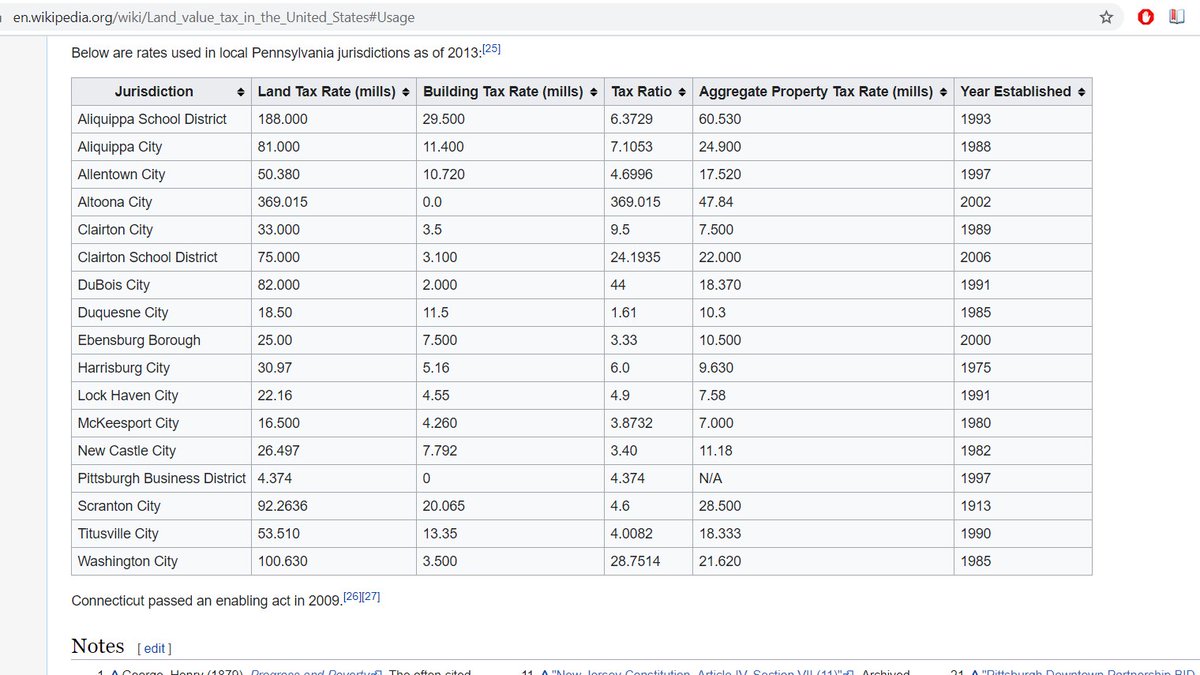
Looking down at the DL&W's old main line. The stretch of track from Stroudsburg to Clark's Summit was among the most tortured bits of that railroad; you went up the Poconos to Pocono Summit down the Poconos to Scranton, and then back up into the hills to head towards Binghampton. 

Elsewhere in their network, the DL&W bypassed big climbs with highly engineered low grade routes (like the famous Lackawanna Cutoff, or the series of grade improvements that gave us the Tunkhannock Viaduct), but the DL&W never got around to fixing this series of climbs
Folks,,,,,,,,,,,,NEW JERSEY #SEANYC 

Why we're really here. These piers are some of the precious few visible traces of the New York, Susquehanna & Western's line to Scranton, which lasted for only from 1892-1939. 



While the NYS&W exists/thrives to this day, very little of its current trackage is actually NYS&W trackage; only the bit of the NJ mainline from Little Ferry to Sparta is original, the rest being a mix of L&HR, Erie and DL&W trackage picked up from Conrail/NS from the 80s onwards 

As for why the original system shrank...it's complicated, and I'll get into it more when we visit Hainesburg, but the NYS&W was a late entrant into Scranton, so its opportunities to get traffic were limited/it had a bad route.
For the section of the line in NJ west of Sparta, NYSW also lost a critical western connection in 1961 when the Lehigh and New England gave up the ghost, causing abandonment of that segment. american-rails.com/images/785910s… 

Crossing under the Lackawanna Cutoff on I-80. The cutoff was quite the feet of engineering; it basically drew a level path across the washboard hills and valleys of Northern NJ, bypassing a steep older main line. Last train ran here in '79; tracks lifted in '84. #SEANYC 

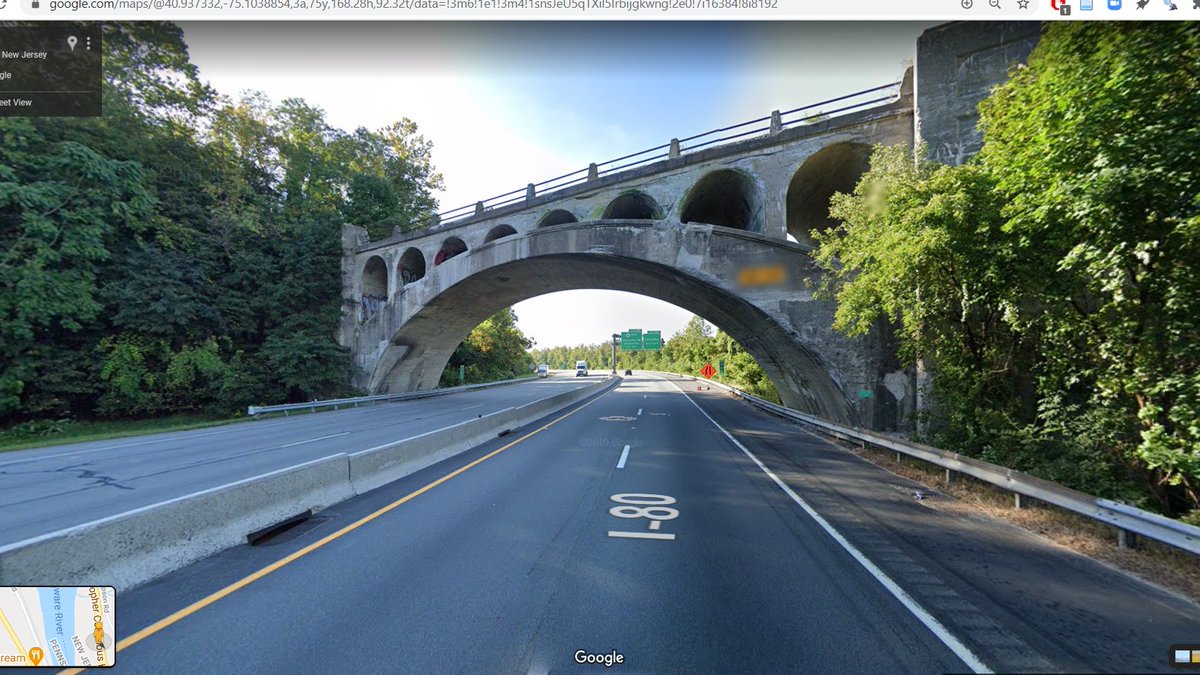

I cover the history of the Cutoff in a bit more detail here (scroll a few tweets down):
https://twitter.com/A320Lga/status/1244085659406647296?s=20
Bangor, PA. #SEANYC 



This area of PA -- loosely, the Lehigh Valley south of the Blue Mountain Ridge -- once produced 75% of cement in the US. Unsurprisingly, the industry has delocalized (cement isn't economical to ship long distances by land); the entire state of PA now produces only 4% of US cement
Cement has certainly left some ~interesting~ landscapes. Note all the quarry-ponds here in Pen Argyl 

Now in the Allentown exurbs here in Wind Gap. This region has had a really frustrating history around land use/transpo planning -- lots of missed opportunities. #SEANYC 
https://twitter.com/A320Lga/status/1285025171213094919?s=20

One of the remaining area cement plants (hiding behind the trees here). Of note, the tracks in the foreground are among the precious few active bits of the former Lehigh and New England Railway, which once linked PA cement/anthracite country with the New Haven RR at Maybrook. 



Above pic from american-rails.com/images/785910s…
When it existed, the L&NE wasn't particularly unusual in its emphasis on anthracite and cement traffic; it essentially acted as a funnel for those products to New England (hence the name).
It did so on a route that was highly optimized for that purpose (~a straight line from coal/cement to Maybrook), but only that purpose; when anthracite entered its decline, it was left w viable-ish lines in PA, but a long and essentially traffic-free mainline through NW NJ and NY
The L&NE never actually lost any money--it was profitable until the end--but these headwinds were ones that mgmt felt weren't worth fighting; in 1961, the L&NE board voted to preemtively abandon the entire system (aside from the Lehigh Valley branches, which were sold)
So after 1961, no more Alco PA's with their fried egg logo traversed the rails of NJ. This also spelled the end of the NYSW west of Sparta, as discussed earler. gsmrrclub.org/HISTORY/histor… 

One of my favorite bits of industrial kitsch: the giant cup atop the ex-Dixie Cup factory in Easton. #SEANYC 

Like any self respecting PA settlement, Easton has teensy little alley streets. #SEANYC 

If I may go backwards for just a sec, I had no idea about this:
https://twitter.com/erstwhileboffin/status/1299159074328674304?s=20
More Easton. Aside from being the one-time home of the Dixie Cup factory, Crayola's HQ is also here, as well as a number of small industrial concerns. Historically, Easton was a point of great transportational import -- it lies at the confluence of the Delaware and Lehigh Rivers 

.....and where the Lehigh and Delaware Canals connected. Fun fact about the Lehigh Canal: before they actually built dams and locks and all, they would ship stuff downriver by building and then breaking temporary dams to create freshets that would rudimentary barges over rapids. 



^that would *carry* rudimentary barges over rapids. Verbs, they are important
The former Lehigh Valley Easton station -- hasn't seen any use since 1961, when the LV ended passenger service. I would argue that one of the more high value passenger extensions in the NYC area would be NJT or Amtrak to Allentown/Reading... 

....and some sort of 1-line regional rail service to circulate people in Allentown/Bethlehem/Easton and Phillipsburg, which is across the river from Easton in NJ. 



On the former site of Bethlehem Steel's Bethlehem Works. While a chunk of the old blast furnace support area and machine shop is now SteelStacks and the (in)famous casino, the vast majority of the old plant's area is now warehousing + an intermodal terminal. #SEANYC 





While this transition means Bethlehem has retained blue collar jobs (albeit ones which pay much less than old steel jobs), it's a mixed blessing. This variety of warehousing = massive air pollution by trucks, (sometimes) exploitative labor practices, job sprawl, etc. #SEANYC
Looking down into SteelStacks in Bethlehem, where the developer left the old blast furnaces standing as a sort of historical curio. 

There's a line to be drawn from efforts to 'heritagize' industrial landscapes in deindustrializing regions to the creation of an unnuanced vision of those places/ppl as being purely and artifacts of heritage/history to the toxic politics of cultural insecurity we see today, IMO
When global perceptions _as well as local economies_ become nontrivially wrapped up in the performance of some place-based history...well, I'd have to imagine that causes discomfort, given that many of the ppl employed in performance once worked in/linked to the real thing
I think that discomfort amounts to a statistical error in the face of the ~completely uncoordinated response to deindustrialization (which itself was caused in part by gov't uncoordination via tax/labor reg arbitrage), but is still interesting to think about
(Hopefully) coming soon to CA #SB1120 

Looking at NS's Allentown yard, which was closed last year. Before then, Allentown had existed in a fascinating and fraught ecosystem of eastern PA railyards whose rationalization evaded planners for decades. 
https://twitter.com/A320Lga/status/1282008912221343749?s=20
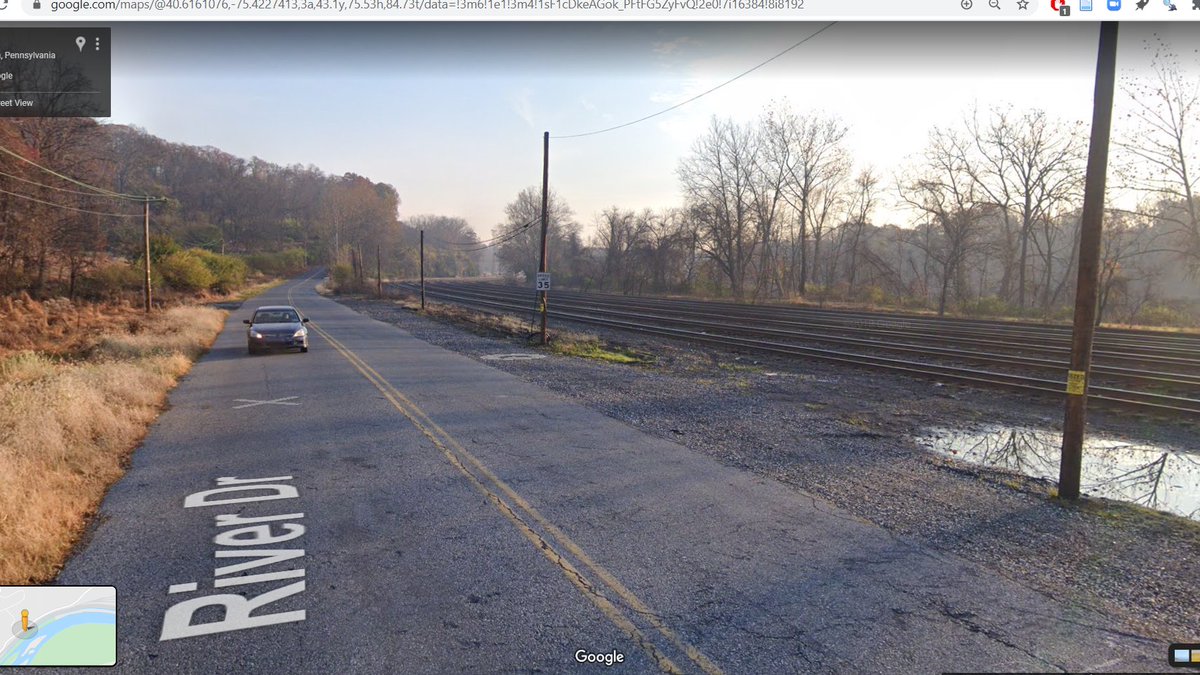
Looking south at CP-HAM in Allentown, the north/west end of Allentown yard and the beginning of the Lehigh Line's much less busy northern section, which carries trains through the Lehigh Gorge to Scranton and beyond (the other section of the LEHL goes to NJ/is v busy). #SEANYC 

This subdivision of duplexes lies on the old site of Western Electric's Allentown Works, part of a sizable ecosystem of northeastern telecoms manufacturing that also included WE's Kearny Works in NJ and facilities in Reading and Mountain Top PA. 

Bell Labs, which did the research/product development for WE was also located nearby: they built a massive campus in Murray Hill (where,= two of my grandparents worked for a time) that replaced their NYC location (yay job sprawl) and became the center of their operations. #SEANYC
The Allentown plant, for its part was at one time a site of some real innovation in high tech mfg: the first transistors were produced here, as were lot of microelectronics used in mid/late 20c US telecoms equipment. #SEANYC mcall.com/news/mc-xpm-19…
.@shadow (who originally clued me into this historical thread in PA) has some more resources linked here if you wanna learn more
https://twitter.com/shadow/status/1298096297400991745?s=20
This is actually sorta cool: this subdivision has preserved the PA (and Radburn-esque) planning tradition of putting service functions (like parking) in back and putting houses at low setbacks against the main street. #SEANYC 



Honestly, one of the best things that cld be done in places like these is allowing neighborhood grocery stores. As subdivisions go, this is decently walkable, but by merit of being 100% resi that walkability doesn't get you much in terms of destinations => you drive to stores etc 

Scenes from around Allentown. The architecture here is an interesting--the Victorian influence is as present as in the other small PA cities visited, but is presented in a more Philly-esque (or simply more urban) attached town-home format for a slightly West Philly vibe #SEANYC 




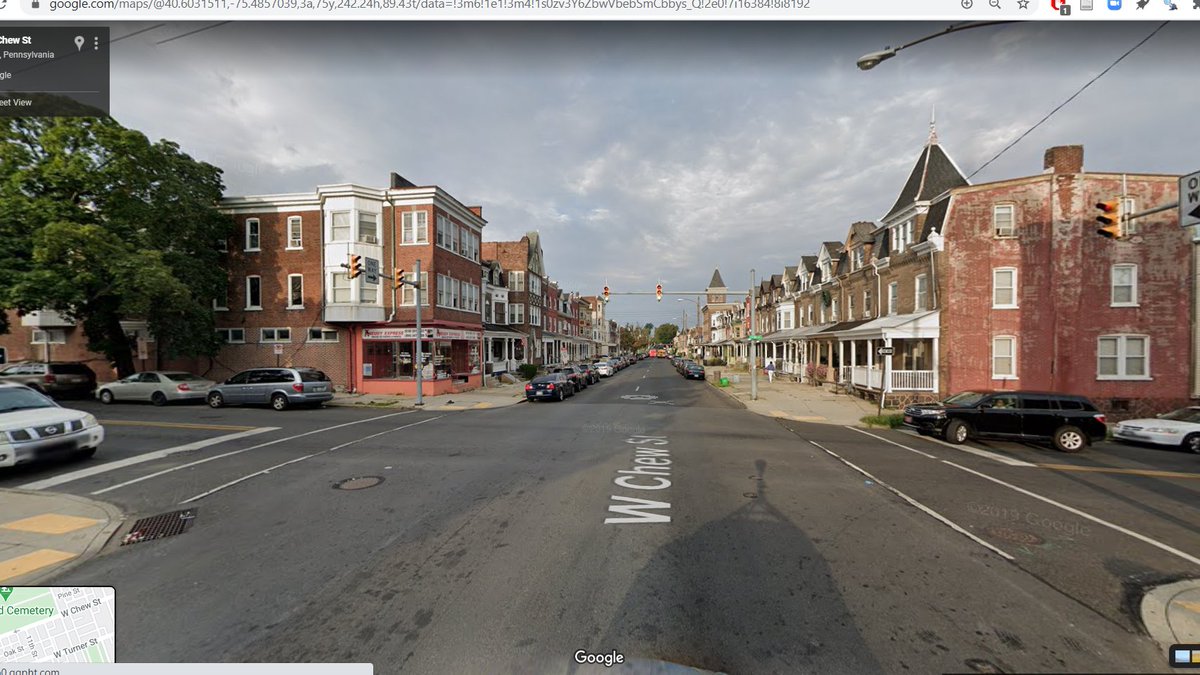
One last thought about Allentown: it typifies the small American city that's remained relevant largely thanks to POC. Lehigh County's non-Hispanic white population has declined by 10% since 1980 against overall growth of 35%.
This isn't an unusual story, but is one lost in the infinite stream of takes by commentators whose perceptions of these places is shaped by interviews with Real Americans in diners after the 2016 election. #SEANYC
Kutztown, one of E PA's (many) German/PA Dutch towns. Transportationally, Kutztown embodies the Lehigh Valley region's priorities: it is surrounded by a massive bypass road, because LOS is king (note that the 4 lane bypass feeds from 3 lane roads on either side) #SEANYC 



As is expected for a town its size, it once lay on an interurban route from Allentown to Reading. Service ended in 1929-30. #SEANYC 

progress #SEANYC 



Some old mill buildings in Reading. Dunno for sure, but Reading once was a big textiles/hosiery town, so it's likely these buildings once were involved in that trade.
Rail line in foreground is NS's ex-Reading Harrisburg Line to Philly.
Rail line in foreground is NS's ex-Reading Harrisburg Line to Philly.

Carpenter Steel's Reading facility. They produce a lot of aerospace-grade steel alloys at places like these (landing gear, engine parts, etc), the high value of which is evidenced by the plant's disconnection from nearby rail lines. #SEANYC 



Driving through some more garden apartment complexes; this one also has rear-facing garages. #SEANYC 



More interesting PA architecture, this time some colonial-ish rowhouses in Wyomissing. #SEANYC 

...and some interestingly wide duplexes in West Lawn. #SEANYC 

Unlike many of the other PA cities we've visited, Reading has a _huge_ job sprawl problem. The densest employment concentration is at a hospital across the river from downtown, and much of the rest of employment is spread out across the innumerable office parks along 422/222 

Ah, the Schuylkill! The Delaware is bigger, but if a river defined Philly's development it was this one. The Lehigh and Delaware Canal systems predated their equivalents on the Schuylkill, but the Schuylkill beat the Delaware/Lehigh systems to the punch on bidirectionality... 

...and once railroads came along, the Schuylkill was the logical route to the anthracite fields/points west, and once had two entirely duplicate routes following its banks to show for it. #SEANYC
The limestone quarries in greater Reading dispatch huge amounts of stone into the Philly market. I believe this specific one (in Birdsboro) ships trains via NS to South Jersey (Winslow Jct) and Delaware. Rock train moves are among the shortest rail hauls you'll find. #SEANYC 


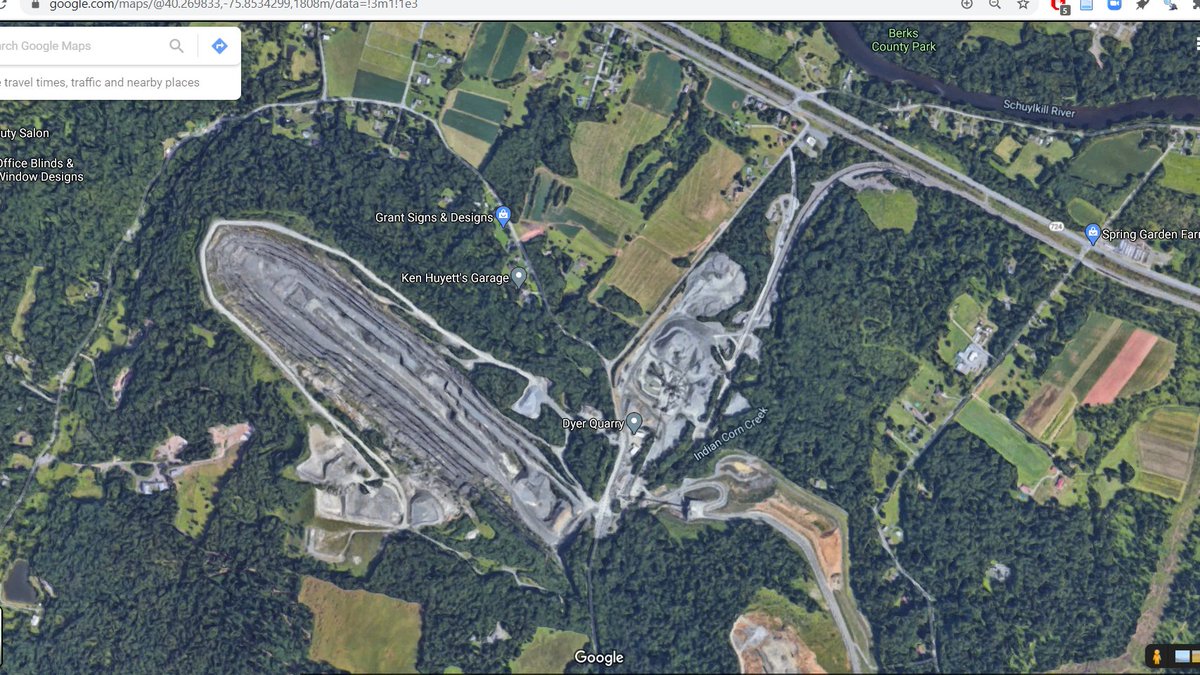
The ex-Reading station in Pottstown. Passenger service hear lasted into the SEPTA era, ending in 1981. Some (very well founded) efforts to resuscitate service have been underway since then but to no avail--see @bensh__'s thread here:

https://twitter.com/bensh__/status/1290952904883478528?s=20

Behind these houses is the portal to the Phoenixville tunnel, which allows the railroad to avoid a long loop around a point in the Schuylkill. 



Because it's single track, this tunnel is supposedly a huge impediment to passenger svc on the line, but a) it sees *maybe* 12 freights/day and b) the limits of the single track are contained w/in the view above. So I'm skeptical.
behind me: Valley Forge
in front of me: King of Prussia
hard to think of two more different landscapes, yet our national fixation with 'authentic' pastoral scenes as can be found in the former is, culturally, much of what drove the creation of the latter. #SEANYC

in front of me: King of Prussia
hard to think of two more different landscapes, yet our national fixation with 'authentic' pastoral scenes as can be found in the former is, culturally, much of what drove the creation of the latter. #SEANYC


For those not familiar, King of Prussia is like a more mall-oriented version of Tysons Corner. It may look like there's a lot going on in this landscape, but it *barely* shows up on employment density maps (its near the far western edge of the map, below the river). 





Left: PRR Schuylkill Valley Branch
Right: Reading RR Norristown Branch.
Both lines were once electrified, and once carried commuter service. Psgr ervice on the PRR ended in 1960 (cut back to Manayunk) and the line's electrification was removed, w/ freight ending ~15 yrs later.
Right: Reading RR Norristown Branch.
Both lines were once electrified, and once carried commuter service. Psgr ervice on the PRR ended in 1960 (cut back to Manayunk) and the line's electrification was removed, w/ freight ending ~15 yrs later.

SEPTA still runs on the Reading into Norristown, but all that's left of the PRR now is the stub to Cynwyd. #SEANYC
Some interesting architectural flourishes on this chiropractor's office in Conshohocken #SEANYC 



This particular motif seems to be alive in Conshohocken. Go Schuylkill vernacular!

https://twitter.com/A320Lga/status/1299852513689165829?s=20

The (spectacular) PRR bridge over the Schuylkill in Manayunk. Structural issues with this span were what caused SEPTA to cut service on the Schuylkill Valley Branch to Cynwyd, but despite their repair in the early aughts, SEPTA never resumed svc. Bridge is now a trail. #SEANYC 

Manayunk is Philly's little Lowell. After the construction of the Schuylkill Canal (& most importantly, Flat Rock Dam), Manayunk became rich in water power dev opportunities which attracted a large number of textile mills, as well as other water-reliant industries (ex: paper). 

Always found it a bit ironic that this little pocket of pre-fossil fuel industrial development only came to be because of one of the country's great early pieces of fossil fuel infrastructure (the canal) #SEANYC
A surviving coal trestle. Trains would shove hopper cars onto the elevated spur, and the hoppers would dump the coal into the bins below, where coal would be sold to businesses/residences. You can find traces of these all along the lines of the anthracite roads in the NE. #SEANYC 

One last Manayunk thought: Manayunk was the Lenape name for the Schuylkill itself; the Schuylkill was a Dutch-ism made from the Dutch word for skulking and the word for river "kill" (which also is part of the names of the Kill van Kull and Arthur Kill in NYC)
Not only were older industrial districts denser, but light industry and housing extensively mixed. Scenes like this were v common in NYC/Philly/Baltimore/Boston, contributing to diversity in immediately available job opportunities to urban residents. 

This, to be sure, had its downsides as well: especially when fewer pollution regs existed, particulate matter/runoff from things like metalwork or vehicle repair or carpentry shops did few favors for neighbors -- and things only got worse when trucks became a thing.
Nevertheless, it's an industrial typology and variety of urban economic landscape that we've largely lost to a potent cocktail of zoning, (sometimes well-justified) NIMBYism and industrial sprawl. #SEANYC
Philly probably has more rowhouses per capita than any other major US city... #SEANYC 







This PHA development (along Diamond St in N Philly) typifies post-1970 public housing projects in the US. After the failures that were the postwar high rise developments, housing advocates turned to scatter-site projects and/or more human scale things like this for PH. #SEANYC 

In their recognition of some of the failings of original PH efforts, these projects have prob been a net +, but some which act as replacements for preexisting PH have led to reductions in housing capacity...
...or have been so budgetarily constrained that they emphasize needs of/capacity for higher income tenants over the needs of housing insecure PH residents. These fights are quite a sad commentary on our (in)ability to consistently provide for the poor.
Crossing the Northeast Corridor for the first time! Fun fact: the track all the way at left is technically not part of the NEC--it's Conrail Shared Assets' Delair Branch, which allows freight trains to get to the Delair bridge to Camden w/o interfering w passenger traffic #SEANYC 

Girard Avenue, with Route 15 streetcar tracks in the middle. From 2005 until this year (when the route was bustituted for equipment issues), the line ran refurbished PCC cars. #SEANYC
en.wikipedia.org/wiki/SEPTA_Rou…

en.wikipedia.org/wiki/SEPTA_Rou…

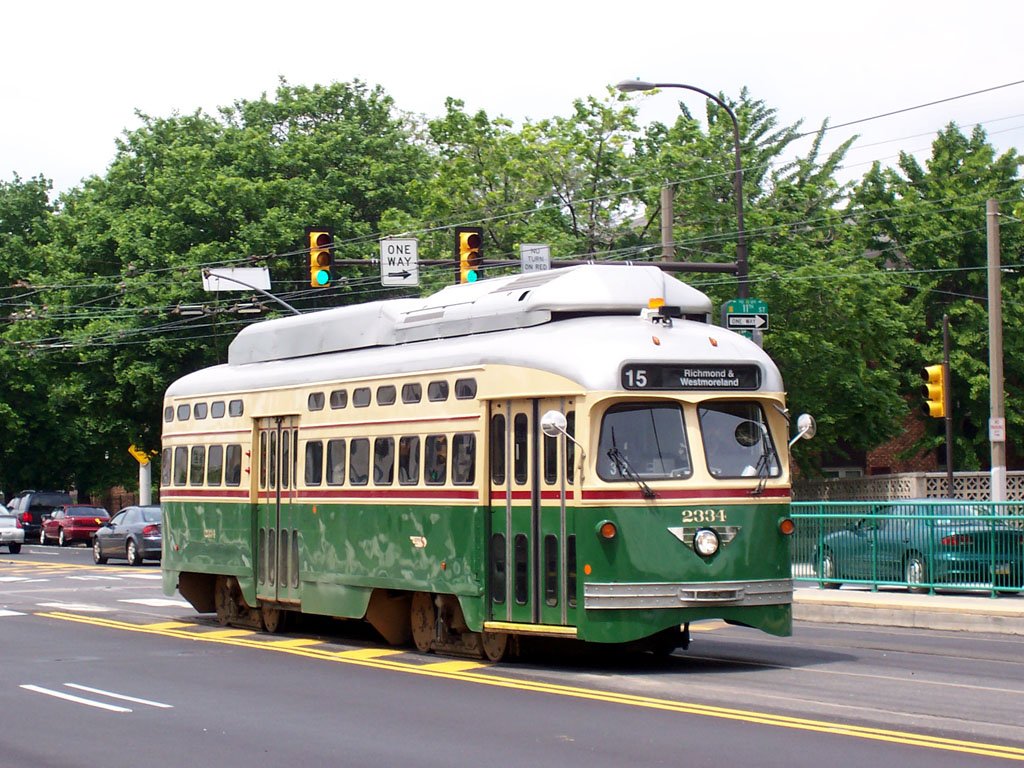
'Twas a fun operation, but reliability suffered from mixed-traffic stretches such as this one. Hopefully a return to streetcar operation will be accompanied with more serious transit priority. #SEANYC
Above us: the NEC entering ZOO interlocking, where trains are sorted btwn routes to NY, Harrisburg, the upper/lower levels of 30 St, Philly's High Line and the old Junction Railroad. Next to us: a boarding island--one of those lil bits of transit infra that can do wonders for ops 



West Philly is interesting. The dominant narrative has been one of Penn-led gentrification -- which certainly is true towards the Schuylkill -- but other areas further west and away from the Market St corridor seem to be undergoing some level of downfiltering #SEANYC 

Will defer to the Philly folks ofc, but this map suggests a trend towards the inner ring suburbanization of poverty #SEANYC
The new rowhouses on this block of Osage St are a physical tell of the destruction that once took place here. This is where the Philly PD _dropped a bomb_ on the headquarters of MOVE, a Black liberation group, after a standoff.
vox.com/the-highlight/…
vox.com/the-highlight/…

The western portal of Philly's subway-surface tunnel. The tunnel -- which runs into Center City, and forms the trunk of a network which stretches out across West Philly -- can carry north of 60 trains/hour during the peak, the best of the US's three subway-surface systems 

(Philly has a bit of an advantage, though, insofar as it has shorter trains, though what seems to make the most difference is extensive use of double-berthing at high-dwell downtown stations)
More info on the MOVE block:
https://twitter.com/bensh__/status/1301647535480680449?s=20
In Penn-land now. Growth in the Penn campus/campus employment have hugely increased job densities in West Philly, which has been good for transit/regional economic fortunes, but has raised issues in university-community relationships... 



...which have, in general, been quite fraught in cities as higher ed institutions navigate urban surroundings that have, on the whole, become poorer/more POC since WW2.
The legacies of urban renewal are esp critical to understanding this problem; unis were frequent benefactors of revitalization/clearance projects #SEANYC
Philly's High Line! This route was -- and is -- a freight bypass around 30 St, which soars over the Penn/Drexel area on a large viaduct on its way south to a junction with the NEC to Washington and the freight route to yards in South Philly. #SEANYC 



C E N T E R C I T Y #SEANYC 

Suburban Station! PRR's downtown Philly commuter terminal, now a stop on Philadelphia's Center City Commuter Tunnel, which I am comfortable calling the most frustratingly underutilized bit of transit infrastructure in this country. 

See, the CCCT has enough capacity to -- and indeed is designed to -- act as a trunk subway for a high frequency Philly regional rail network that would provide fast/flexible transit to the city and region.
This indeed was the plan, but thanks to funding issues/politics/labor issues, it never came to fruition. If you want to tear your hair out over things that could have been (and still could be!) look up Vukan Vuchic's plans for the system, ex:
core.ac.uk/download/pdf/2…
core.ac.uk/download/pdf/2…
Before the CCCT, the other half of SEPTA's regional rail services (those once operated by the Reading) terminated here at Reading Terminal. The building is now a market #SEANYC 

Reading's City Branch! A freight artery through ex industrial districts north of Center City to the massive facilities at Port Richmond. The line, which runs in a subway for part of its length, was active until '92 when the last load of newsprint arrived at the Inquirer's spur 





Some 'urban suburbia' in Poplar. A lot of HOPE VI, CDBG and HUD-community partnership projects ended up taking forms like these, in part thanks to the backlash to the classic high rise public housing typology. Another famous example is the redev of Charlotte St in the S Bx 

Some old industrial trackage in Northern Liberties. This area has become residential (another post-industrial sacrifice zone for housing production) as industry sprawled and headed/south/west/overseas; am surprised these bits of track haven't been paved over. #SEANYC 



Let this also be a friendly reminder that there was a fully functional goods distribution system for cities before trucks that minimized emissions/pedestrian risks/etc, and we essentially subsidized its competition into total market dominance.
Other factors, like a wish to escape union power, build larger plants, and realize the full industrial engineering gains of plant electrification, were at play in sprawl, but freight transport shifts were absolutely key. #SEANYC
This empty expanse was once a gigantic rail-to-water coal transshipment facility. Anthracite from PA would come on Reading RR trains here to be loaded onto barges/freighters for distribution along the Delaware and up/down the coast. #SEANYC
reddit.com/r/philadelphia…

reddit.com/r/philadelphia…


Tioga Terminal! Among other things, this facility is an important import point for eucalyptus pulp, which travels from Brazil/Ecuador to here, and then is loaded into boxcars for the haul to mills -- some of which are as close as Chester and Mehoopany #SEANYC 



Eucalyptus pulp production isn't great for the environment, though. Its value in world pulp markets lead to extensive plantations, replacing native vegetation and frequently increasing erosion and fire risks. #SEANYC
Looking through the approaches to the Delair bridge (used by Conrail/NJT to South Jerz) at the Betsy Ross Bridge, a span whose story is one of self-justifying infra. 

When built, the Betsy Ross connected to little of import on the NJ side...but in order to get a good ROI, that had to change, so a bunch of highway expansions were done to increase access to the bridge. Now it gets more -- though still underwhelming -- use. #SEANYC
Rowhouse-duplexes in Bridesburg #SEANYC 

Philly, too, has trolleybuses (though they seem hell bent on changing that, sadly)...#SEANYC 

It's a common refrain on transit twitter, but it bears repeating: trolleybuses are a _really_ underrated solution to urban bus electrification. They work! They don't have issues in the winter! #SEANYC
Northeast Philly has mile upon mile of buildings that use this material palette and general vernacular. Very postwar. #SEANYC 

Ok looks like the N Philly trolleybuses are safe
https://twitter.com/bensh__/status/1302420546404130816
Northeast Philly is politically, demographically and geographically quite similar to Staten Island.
- Postwar growth w/in city limits
- White, but diversifying
- Votes R much more than the median metro-area suburb
#SEANYC

- Postwar growth w/in city limits
- White, but diversifying
- Votes R much more than the median metro-area suburb
#SEANYC
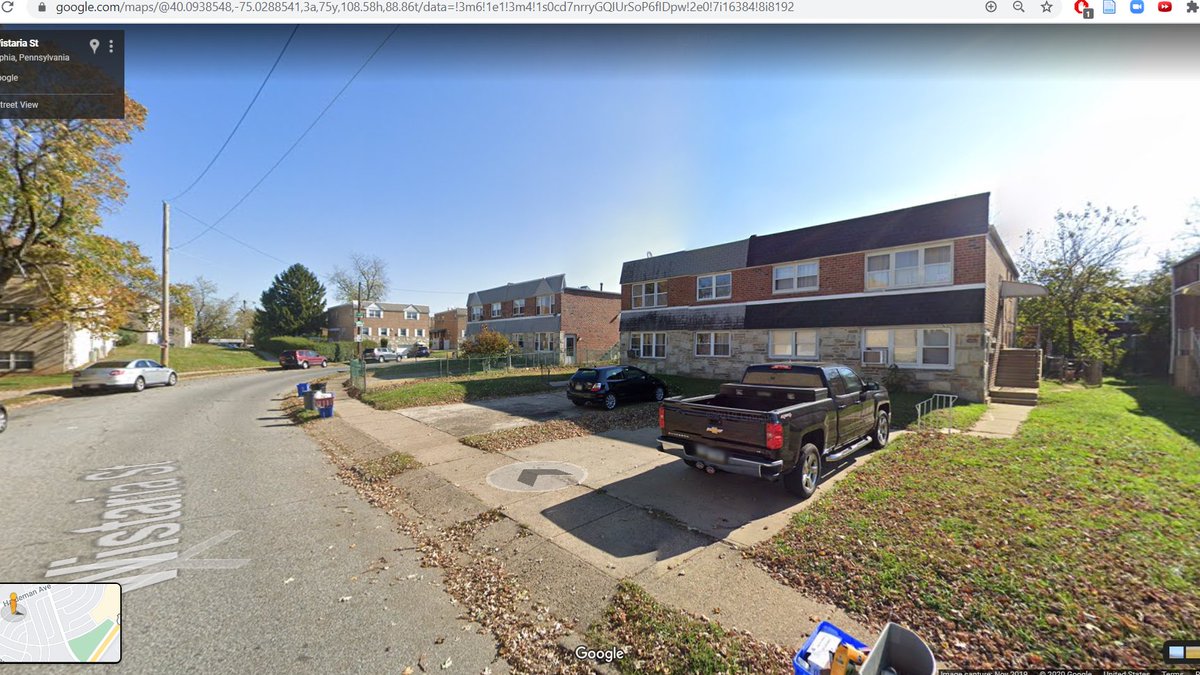

Roosevelt Boulevard is like the least endearing parts of Eastern Parkway and Conduit Avenue got made into one road and put in a y i k e s land use regime. One day, sometime far in the future, it'll get a subway. Hopefully. It sure could use it. #SEANYC 

SEPTA Eddington: literally two sheds across from each other along the NEC in the midst of an extremely ped-hostile street environment. The state of regional rail in Philly makes me so, so sad. #SEANYC 



Try as Amtrak might to scare freight users away, a decent amount of freight still uses spurs fronting the NEC. It's a far cry from what it once was, but this industrial park has a boxcar user at left, and at right (hiding behind the parked cars) some covered hoppers. #SEANYC 

Burlington NJ. Back when NJ was two separate colonies (East and West Jersey) Burlington was the capital of West Jersey. The two halves were consolidated to make the current whole in 1702, but the old boundary lives on in the SW borders of Ocean, Monmouth and Somerset Counties. 


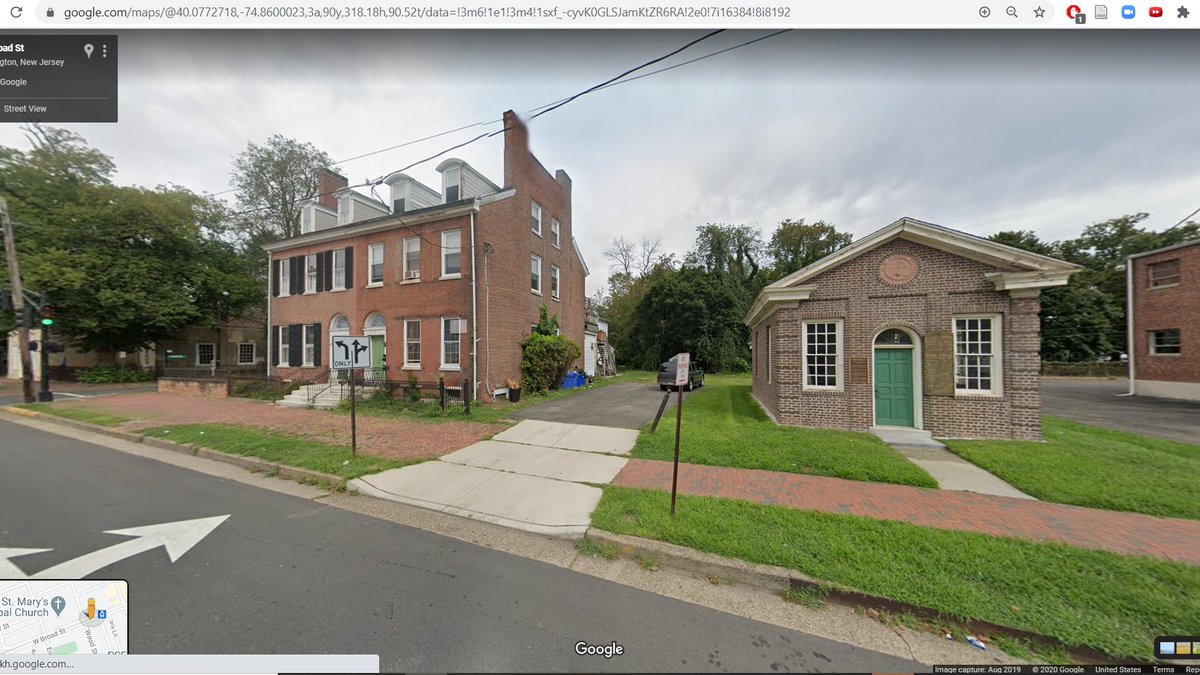


(Burlington is also where Burlington Coat Factory was founded, as sort of the prototypical outlet store selling discount clothes out of some sort of cheap industrial space)
NJT's River Line runs right through downtown Burlington. This route, which actually could be v useful if not for SJ's land use choices, was a pioneering user of second gen (ie not RDC) DMUs.... 

...and, after applications in San Diego and Baltimore, became (and still is) a user of temporal separation arrangements to allow FTA-regulated passenger trains and FRA-regulated freight trains to share tracks safely.
On the River Line, this is achieved by moving most freight to night hours, and by providing short intervals of absolute protection for daytime freight moves across River Line trackage. #SEANYC
Roebling NJ. In the early 1900s, the Roeblings (yes, the famous ones involved w/ the Brooklyn Bridge) built a large mill and wire works here, and a company town along w/ it. Unlike many other US company towns, a decent amount of effort was invested in the urban design in Roebling 





(though, ofc, design features reflected the corporate and social hierarchies present at the time, in keeping with the mission of social control that undergirded many such developments)
Nevertheless, Robeling and this landscape of rooted industry is quite the contrast with the surrounding landscape of industrial mobility -- distribution centers, warehouses and the like. 

Having been unbound from site by trucks, containers and consolidation, industry (as we all know) has a huge degree of locational freedom, with these warehouses the only thing that must be near fixed places, like cities.
But even warehouses exist in their own ecosystem of transiency -- much of modern warehousing's cost-effectiveness relies on high turnover/low wage/de-skilled labor and various forms of temp work. #SEANYC
Bordentown, NJ:
- Contains much good S Jersey architecture
- Joseph Bonaparte lived here
- Was on one of the first railroads in the US, the Camden and Amboy. The C&A ran from Camden to the Raritan Bay at S Amboy and was opened in 1832
- Has alleys
...so, an interesting place



- Contains much good S Jersey architecture
- Joseph Bonaparte lived here
- Was on one of the first railroads in the US, the Camden and Amboy. The C&A ran from Camden to the Raritan Bay at S Amboy and was opened in 1832
- Has alleys
...so, an interesting place




Chesterfield Township is among a handful of municipalities that has a transfer of development rights provision. 





The TL;DR on TDR is that areas are zoned for conservation or development, and those owning conserved lands can sell dev rights to those wishing to build above zoned density on buildable plots
The area zoned for development, shown above, has been built up along vaguely New Urbanist lines with alleys and sidewalks and small setbacks (though, oddly for such a clearly sustainability-planned community, I don't see any walkable retail?) #SEANYC
It's an interesting sprawl control technique in a state whose modern history has been largely defined by various sorts of satellite development from out of state urban cores. #SEANYC
The entrance to the McGuire-Dix-Lakehurst joint base, an amalgamation of Army (Dix), AF (McGuire) and Navy (Lakehurst) bases. 

These bases have seen a lot -- the Hindenburg disaster, numerous anti-submarine patrols during WW2, a large complement of nuclear SAMs, a very early computer radar processing installation. #SEANYC
The Pines, the lovely lovely Pines. The NJ Pine Barrens are a massive, fascinating, and largely untouched ecosystem defined by its awful soils, gigantic aquifer, carniverous plants and dense pine forests (containing some rel obscure pine species) 



A lot of the area (which, speaking in terms of ecoregions, also includes much of LI and far eastern/southeastern MA) was formed from sandy glacial outwash during the last ice age.
LI and SE MA having been largely built up, the pines are the largest remaining example of this nutty type of forest -- and they're now preserved, under the jurisdiction of the Pinelands Commission.
While the pines have remained untouched, their resources haven't. The high quality sand that lies under the pines gave birth to the American glassmaking industry; what's believed to have been the first glass factory in the current US was set up in South Jerz in 1739.
Fueled by this high quality sand (as well as plentiful lime from -- get this -- oyster shells discarded by SJ oyster canneries) the SJ glass industry grew massively with industrialization and the growth of bottled things and windows.
As the former market shrank the glass industry did too, but it, and associated sand mining activities, are very much still around! (Pics from when I dragged the family to a SJ sand mine) #SEANYC 




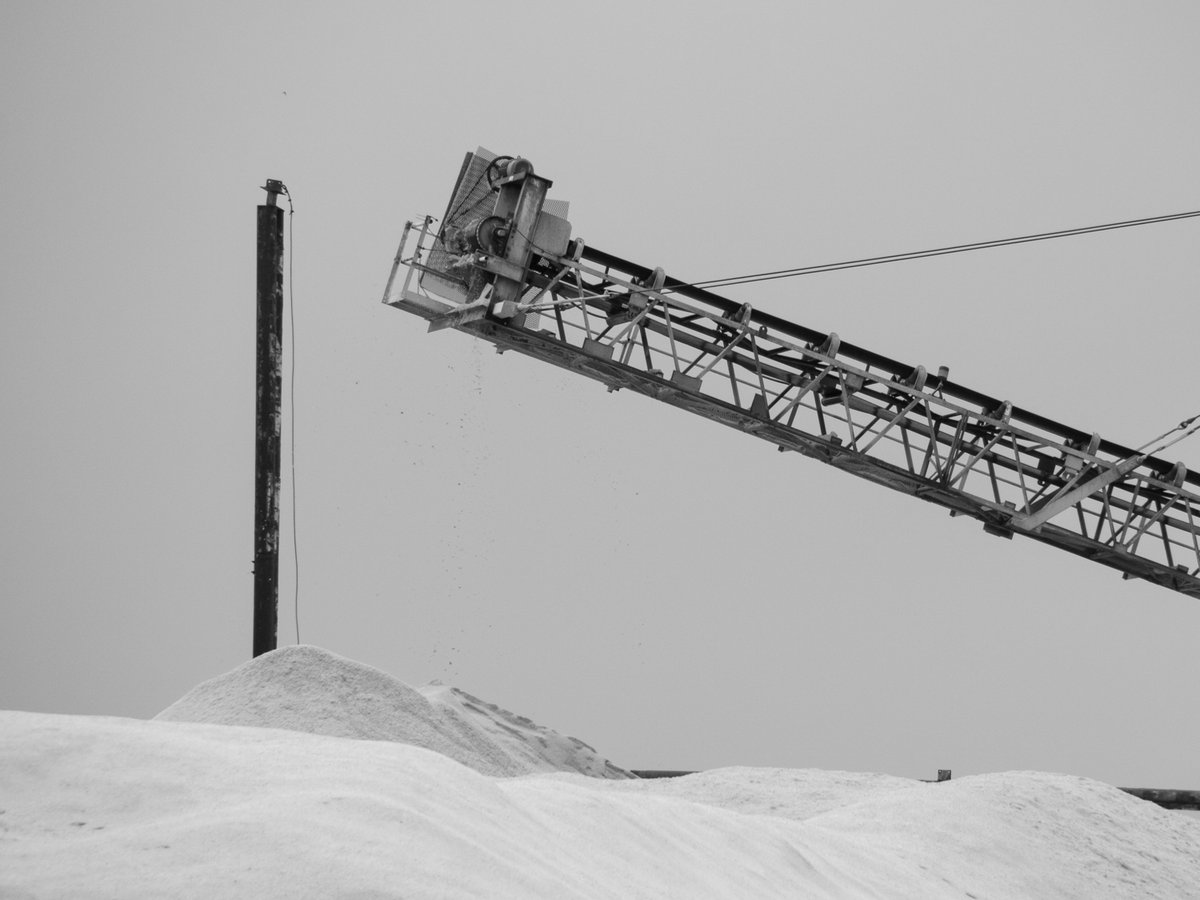


Looking down over the CNJ Southern Div in Lakehurst. This line, which once linked SJ towns/sand mines/oyster canneries/glass plants with North Jersey and NYC via the Pines, has been out of service south of here since 1985ish, and south of Lakewood (a few miles north) since 2010. 

Efforts have been underway to bring the line back as far as the sand pits at Woodmansie, but so far no trains have run. This really should be done -- sand trucks aren't doing Ocean County roads any favors!
Some shots of the line while active (incl one from under my overpass):



Some shots of the line while active (incl one from under my overpass):




All shots from:
web.archive.org/web/2007031905…
web.archive.org/web/2007031905…
Ocean County's demographic landscape is defined by the belt of second-wave sprawl that stretches from Somerville to Toms River. The median home in OC was built in 1980, and the landscape shows it.
Sorta unsurprisngly, OC was where Trump won his largest margin in NJ #SEANYC

Sorta unsurprisngly, OC was where Trump won his largest margin in NJ #SEANYC


Behind these gates lie the former Ciba Geigy Toms River dye plant. Active from 1952 to the mid '80s, the plant is infamous for having hugely polluted the groundwater in/around Toms River, discharged large amounts of untreated waste into the Toms River itself... 

...and (perhaps) caused a cancer cluster.
I say "perhaps" because the Ciba plant wasn't the only polluting mess in the Toms River area; someone also once had the bright idea of dumping a bunch of chemical waste into an unlined pit near the source of Toms River's drinking water.
I say "perhaps" because the Ciba plant wasn't the only polluting mess in the Toms River area; someone also once had the bright idea of dumping a bunch of chemical waste into an unlined pit near the source of Toms River's drinking water.
A truly massive grade crossing gantry protecting the spur that once served the Ciba plant #SEANYC 

The actual town of Toms River is quite old. Before 1812, there was an inlet to the sea adjacent to it (see map; look for Cranberry Inlet) which made it a decent harbor for (among other things) privateers. Inlet is gone, but the town remains. #SEANYC 





Seaside Heights! Before I talk abt Sandy, fires, and local vacationing, I want to point out the width of the street here. This stroad-with-service-roads is not just highway engineer excess -- it's a remnant of when there was a railroad here. 





For a brief period in the late 20s and early 30s, the PRR (through its partnership w/ the Reading, the PRSL, and its control of the Tuckerton RR) had a nearly comprehensive NJ coast network. 

Since then, storms, fires, cars, and airplanes have deconstructed it, but the current NJCL and Atlantic City lines remain, as does the Cape May route (albeit w/o passenger svc). #SEANYC
Pics from christophervaz.wordpress.com/tag/pennsylvan…
seasideparknj.org/images/train.j…
Pics from christophervaz.wordpress.com/tag/pennsylvan…
seasideparknj.org/images/train.j…
What Seaside Heights is best known for, however, is its boardwalk and amusement park.
Back when NJ coast towns (and Coney Island/Rockaways) were the beach vacation options for those in NY/Philly, there existed a massive beachfront entertainment industry on top of beachgoing.
Back when NJ coast towns (and Coney Island/Rockaways) were the beach vacation options for those in NY/Philly, there existed a massive beachfront entertainment industry on top of beachgoing.

Seaside Heights' boardwalk was part of that; it once was lined with all sorts of stores, shops and rides, with massive hotels like this one not far away. seasideparknj.org/images/history… 

Places like these declined the world over as car and (especially) air travel became more accessible. You see this same pathology in Brighton, England as well, for example.
Seaside Heights has persevered, though hardly has been free of challenge: Sandy, and then a massive fire in 2013 (which destroyed things that had just been rebuilt after Sandy) didn't do the town any favors. inquirer.com/philly/news/ne… 

*IF* COVID leads to any behavioral shifts, it'll be interesting to see how things shake out for more accessible vacation spots like these. #SEANYC
Sandy in buildings: new things on the shore don't have more than garage space below flood elevation #SEANYC 
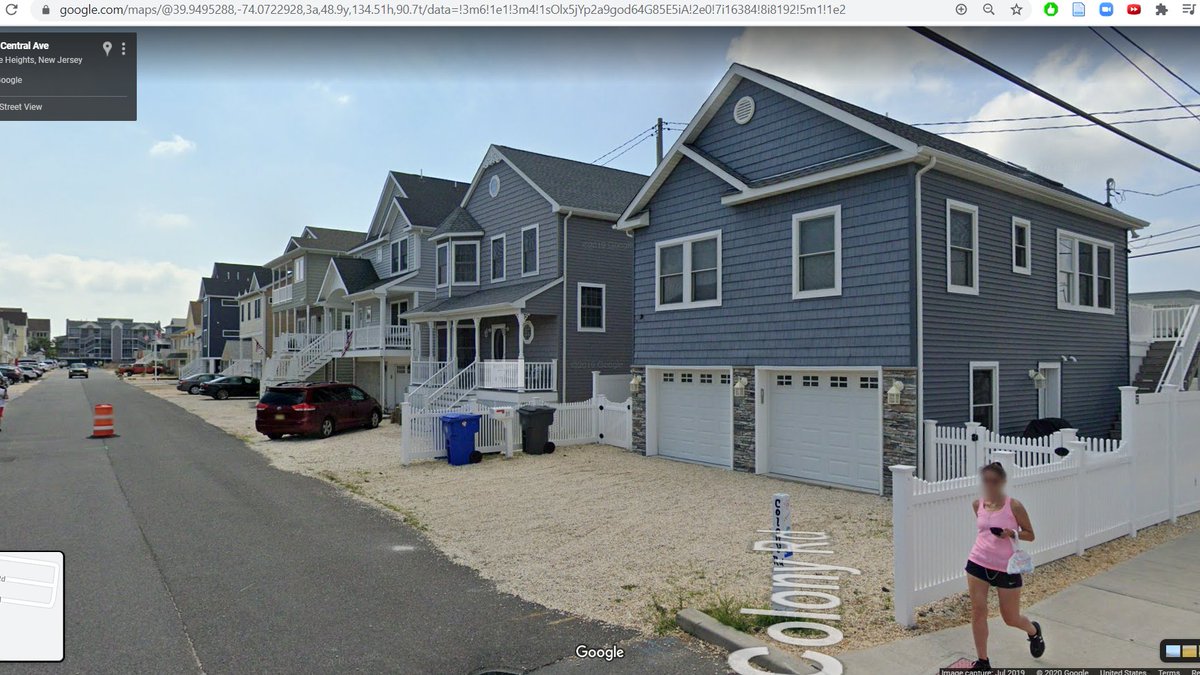
New Jersey's coast is littered with shipwrecks. Being near a big port and on the path of frequently extreme weather, an unimaginable amount of misfortune has befallen shipping off this coast. It's difficult to find a mile of beach that hasn't been the unplanned end of a voyage. 



This stretch of the Atlantic coast was especially...tense during the earlier years of WW2. Pipeline and rail capacity wasn't sufficient for domestic fuel transportation, so a lot of oil moved by sea from the Gulf to the East Coast -- movements targeted by Nazi U-Boats.
Tons of money was thus spent on watchtowers, Lakehurst-based blimp patrols, convoying, etc. -- infrastructure that in large part still exists.
Cold War coastal defense schemes have also left their mark on the bottom of NJ's coastal waters. One of the more strange military installations of the Cold War were the Texas Towers, a group of early warning radar stations mounted on oil rig-like platforms off of NY.
One of these -- Texas Tower 4 -- was built in rel. deep waters, damaged in transport to its emplacement, had its integrity repeatedly questioned by its crew, and ended up collapsing in a storm in 1961. en.wikipedia.org/wiki/Texas_Tow… 

Loving the road-style 5mph sign for NJT trains entering Bay Head Yard #SEANYC 

...and Bay Head station itself, among the few NJT stations that has a 'real' platform serving only one of its two tracks. If your southbound train arrives on the left track (which most do IINM), get ready to walk over some gravel. #SEANYC 

The only other NJT station with this feature is Manasquan, two stops to the north of Bay Head.
Semi-relatedly, it's just nuts to me that the NJCL isn't electrified to Bay Head. Stop spacings are so short -- the acceleration capabilities of EMUs would be put to good use!
Semi-relatedly, it's just nuts to me that the NJCL isn't electrified to Bay Head. Stop spacings are so short -- the acceleration capabilities of EMUs would be put to good use!

I KNEW I had forgotten something. (Lincoln Park on the MoBo and Bernardsville/Murray Hill/Stirling on the Gladstone are like this too, I realize now that I've thought about this more properly. Not sure the Bernardsville one is actually used though.)
https://twitter.com/jeremyzorek/status/1304264867654840320?s=20
Lakewood is an interesting place. Like Toms River, it's second gen car sprawl, but unlike TR the town has become home to a large Orthodox community (seeded by migrants from Brooklyn IINM), who comprise 60% of the town's population. One of the largest yeshivas in the world is here 

One of Monmouth's many stroads. More so than Ocean County, which has rel sparse legacy rail infra in growing areas as a passable excuse for their transpo...issues, I find the way Monmouth has grown to be quite sad. They have the NJCL, and active/low-density freight lines inland 

Roosevelt, NJ was one of a number of collective settlements founded during the New Deal. This one was intended as a resettlement location for tenement-dwelling Jewish garment workers in the Northeast, and originally had a garment factory attached. 





Tenants bought a share in the scheme, and then got settled in one of the Louis Kahn designed houses pictured above. The experiment was a failure, but remains an interesting artefact of a certain era in anti-urban collectivist/modernist planning thinking. #SEANYC
Possible it's just me, but if you plopped me down in Hightstown NJ and gave me no context, I'd probably place myself a decent bit further south than I am? Like rural MD or smth? 



The other half of the equation that creates NY-related industrial sprawl in places as far flung as Hazleton is land use like this. AFAICT, the avg NJ municipal zoning code limits industrial building heights to 50', making multi-storey complexes barely possible/impossible. 

So what we've ended up with in Northern NJ is a structurally undersupplied warehouse market gobbling up what little brownfields/greenfields remain undeveloped, and then tons of less geography-sensitive things wandering out into the beyond. Not! Good!
(Sprawling industrial land use also reinforces car-dependency by making transit less economical to operate, thus hurting generally low wage drayage/distribution workforces)
You'd never know given how truck-oriented it's become now, but a key factor in the growth of this warehouse cluster *here* was that shippers could access rail _and_ the Jersey Turnpike from cheap-to-develop greenfield land. historicaerials.com/location/40.36… 

I've talked a lot now about the failures in modern garden apartment neighborhood location/planning, but one super frustrating angle to the whole issue in NJ is that these apartment complexes .built away from transit/amenities/etc are frequently those mandated by... 

.. NJ's fair share housing doctrine, the Mount Laurel doctrine (which you should read about). So you get the new housing, but it's not always well located, and location means a lot! #SEANYC
(NB: I'm not sure whether the dev pictured above is an example of this particular trend!)
(NB: I'm not sure whether the dev pictured above is an example of this particular trend!)
Obviously this is better than is done in most US suburbs, and not all NJ suburbs do this marginalization, but still, an issue worth discussing.
Now in New Brunswick, a fascinating, dense NY satellite city home to Rutgers. It hasn't become as big of a secondary office destination as, say, Stamford, but the hospital and J&J HQ make it v job dense. #SEANYC 



Rutgers and a Schneider dry van: doesn't get more Central NJ than this! #SEANYC 

For @jeremyzorek, who if it wasn't for *gestures around* would be here:

https://twitter.com/jeremyzorek/status/1304616675288010753?s=20

The Delaware and Raritan Canal along the Raritan near New Brunswick. This canal was an important artery for coal/bulk goods/mfg things during the early/mid 1800s, but was eclipsed by the piece of infra in the tweet above. Unlike other NJ canals, most of the D&R still exists. 

In Somerset County's belt of post-2000 sprawl on my way to Manville. Unsurprisingly, very few people in this area commute on transit. But when NYC and inner ring NY suburbs don't build housing... #SEANYC 



Downtown Manville. As its name suggests, Manville was a company town built in the 20s and 30s for the Johns Manville Company's asbestos insulation and roofing plant. The plant's toxicity was really...something. Workers involved in asbestos processing were, ofc, hugely impacted... 
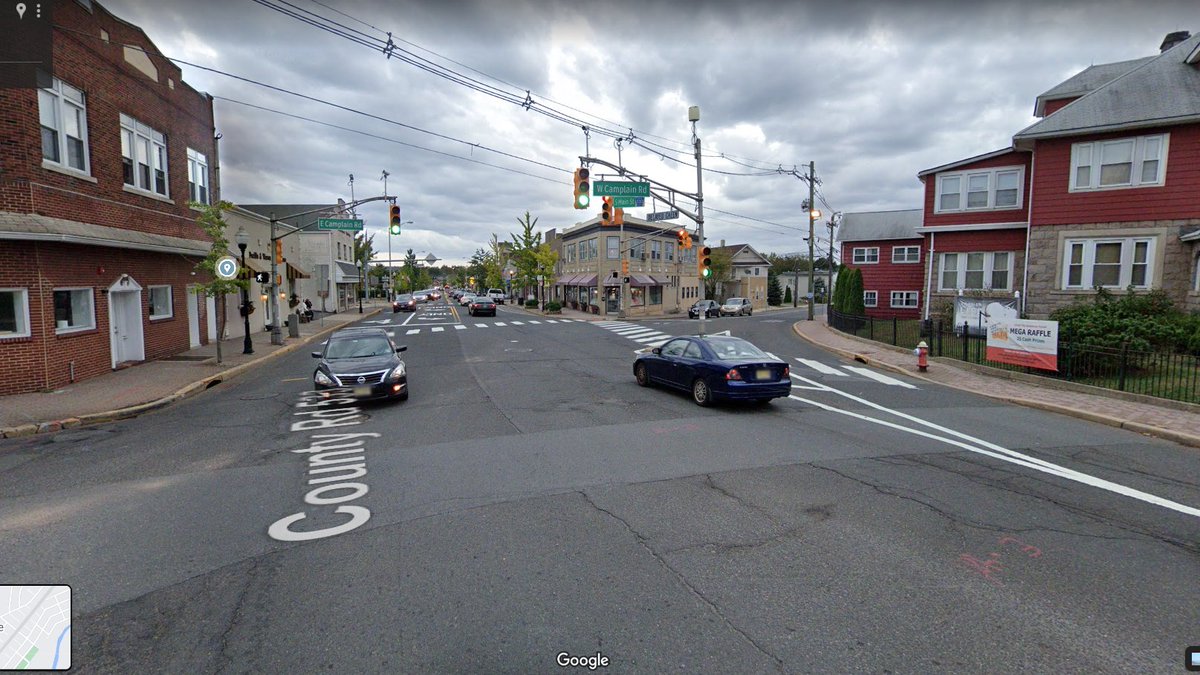
...but so, too, were those in the town: the plant used to emit so much asbestos dust that residents would talk of 'asbestos snow' during the summer. Asbestos being a carcinogen whose pathway is respiratory, that was...bad. #SEANYC
Manville today seems to have integrated itself into the landscape of central jersey suburbia; its demographic profile is not *too* dissimilar from other middle/working class towns that generally follow the Raritan Valley Line corridor.
(Aside: I hope one day to have the time to study suburban deindustrialization in more detail. The jobs/opportunity/replacement ecosystem therein is would seem to be v different from those seen in urban/rural cases.) #SEANYC
NJ's Chemical Coast (along the Arthur Kill from Elizabeth to Perth Amboy) is the best known locus of chemical production in the state, but there once existed a sizable cluster of chemical industries in the Manville-Bound Brook corridor. (pictured: fmr site of American Cyanamid) 



These funky looking duplexes (?) are something I've only ever seen in this part of NJ. #SEANYC 

Now in Bound Brook. Like many NY-area suburbs, Bound Brook saw a late-20c/21c influx of immigrants -- in this case, many Costa Ricans. The town is now somewhat of a cultural hub for the CR-American community; I believe CR's president actually visited the town a few years ago. 



Honestly this is one of the more clever integrations of a power line ROW into a development I've seen. Free lawn! #SEANYC 

One of the easiest ways to date factory buildings is by their window use. Older factories, built before electric lighting was cheap, have tons--they were called "daylight factories." If I had to guess, this building was built sometime btwn 1900 and 1930. #SEANYC 

(h/t to @MarketUrbanism for catching typo in original version)
There's a lot to unpack here, in this multiplex. Really here for the different siding colors. #SEANYC 

This diner in Plainfield was the flashpoint of a 1967 riot in the town, which was one of many suburban/rural conflicts that summer whose histories are not nearly as well represented in mainstream history as urban riots in places like NY. #SEANYC 

The causes of riots in Plainfield were similar to those in cities -- discriminatory treatment by gov't and police, disinvestment, inequality, poor representation in town politics, a middling gov't response to organizing + protest in the earlier years of the Civil Rights Mvmt --
...and were followed by a similar pattern of further disinvestment and white flight, but I think it's worth remarking on how the classically-metropolitan dynamics of racialized spatial social inequality and white flight played out within a small industrial/bedroom suburb of NYC.
.@TomSugrue and Andrew Goodman makes these observations much more eloquently than I here; if you can get access, I highly recommend reading this article. Has really informed my thinking on inner ring suburban demographic/political dynamics.
journals.sagepub.com/doi/abs/10.117…
journals.sagepub.com/doi/abs/10.117…
(This sort of suburban industrial growth => POC pop growth dynamic is also an important one to look for when trying to determine how mid-century suburban municipalities treated POC when they were present w/in their gov't boundaries. Answers are ~never positive, IME)
(There's def a through line from the patterns of institutional behavior observed in places like Plainfield in the 50s and 60s to what has been taking place in places like Ferguson as poverty and BIPOC populations increasingly move outwards from urban cores)
• • •
Missing some Tweet in this thread? You can try to
force a refresh





















